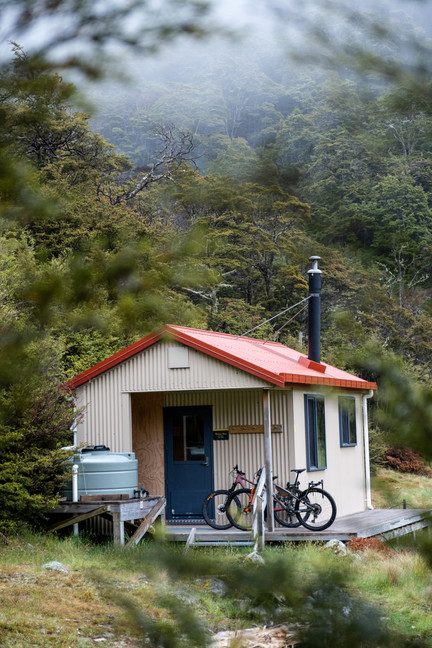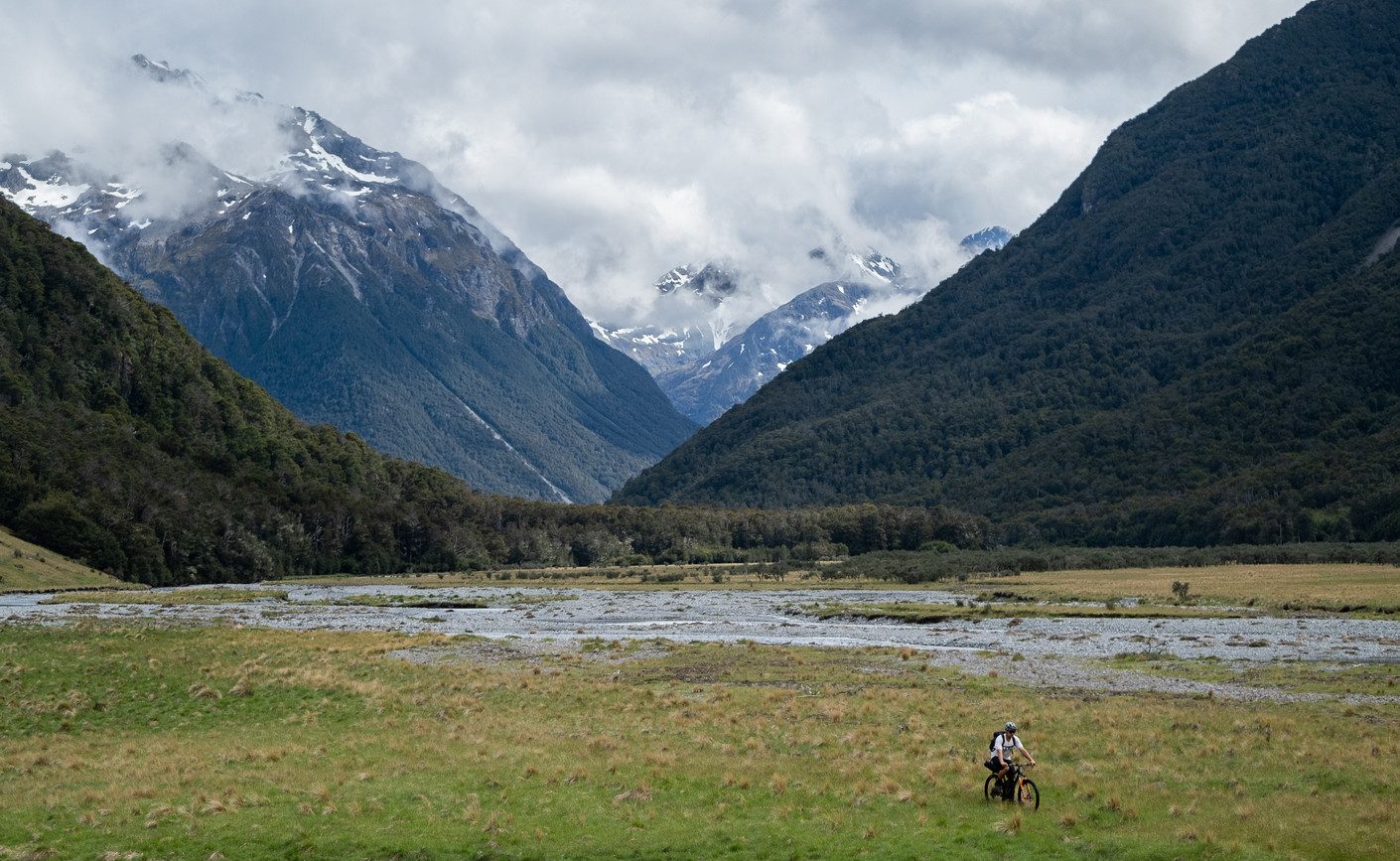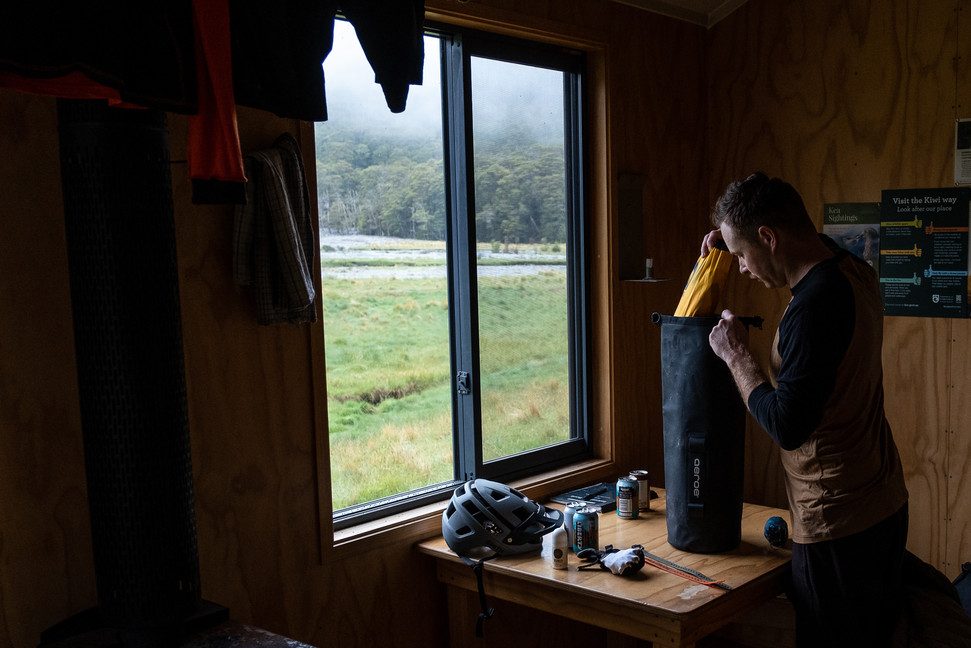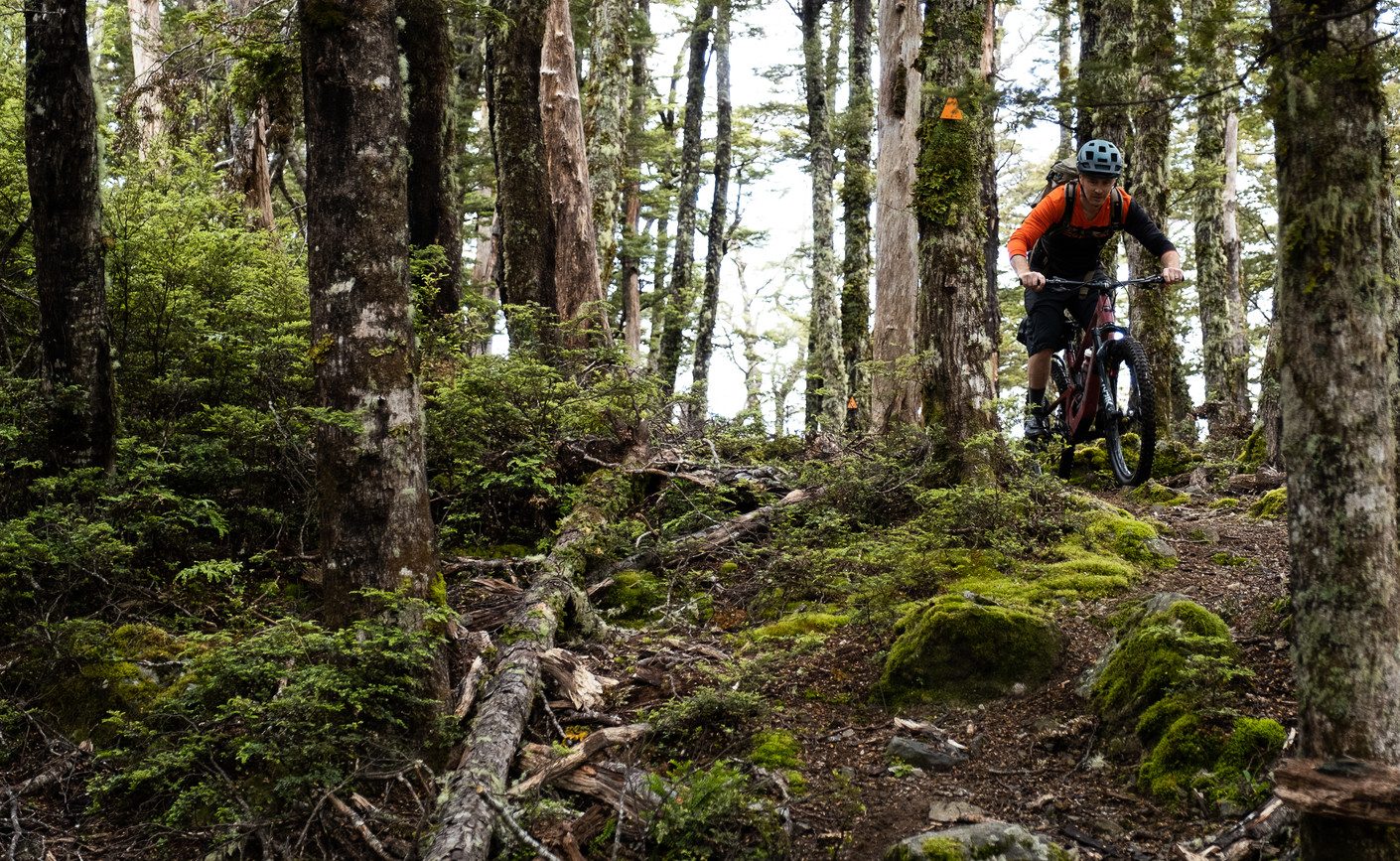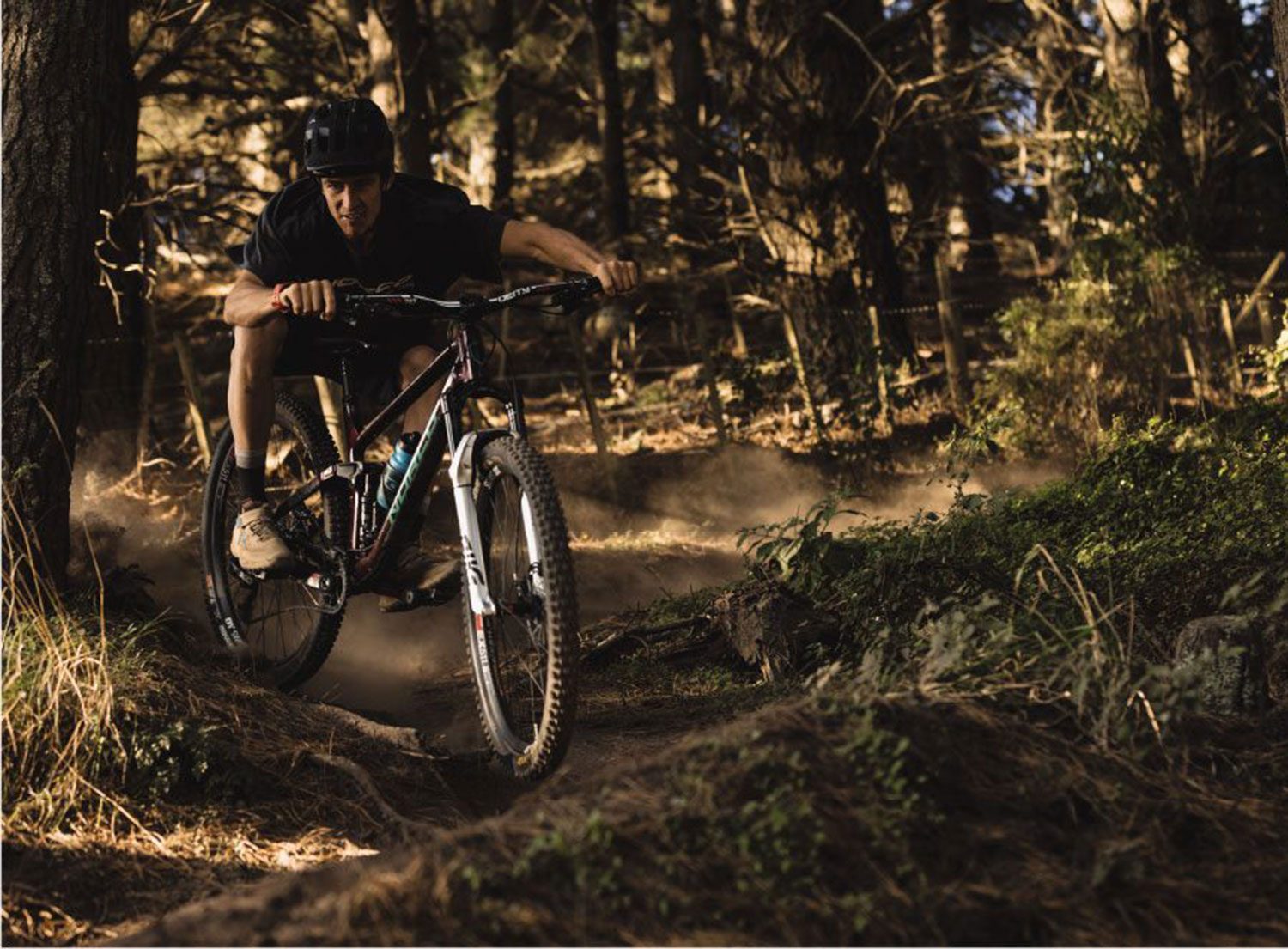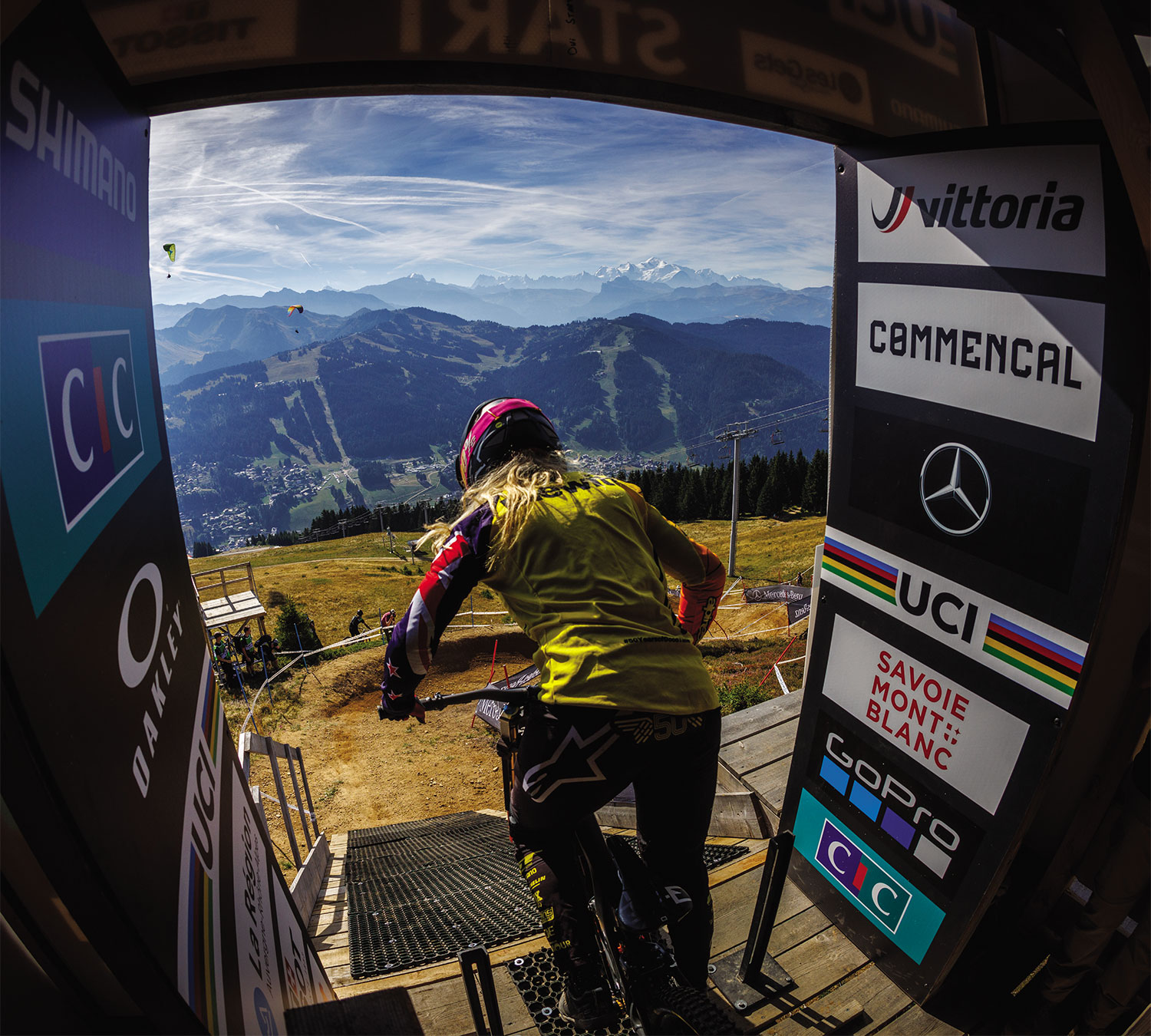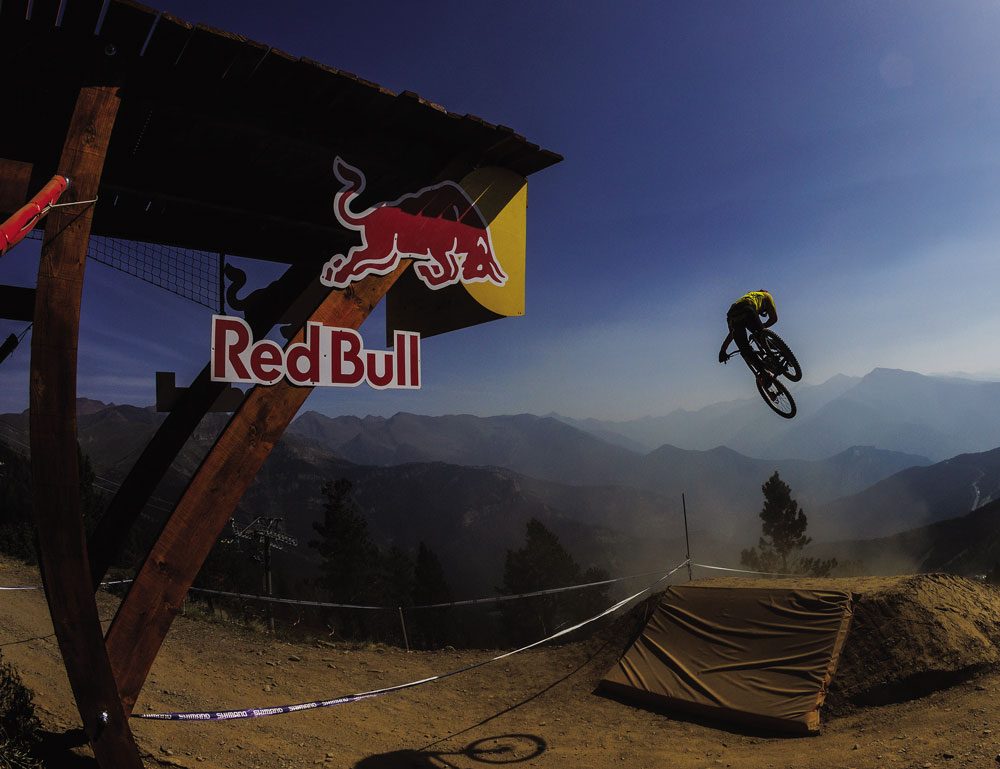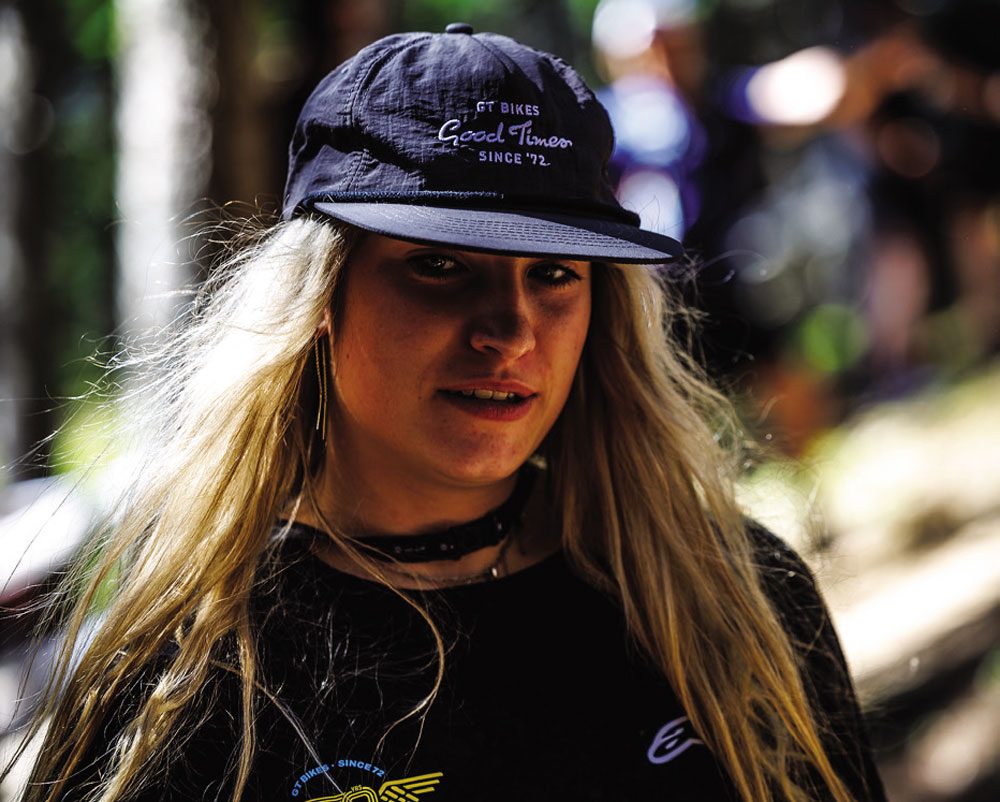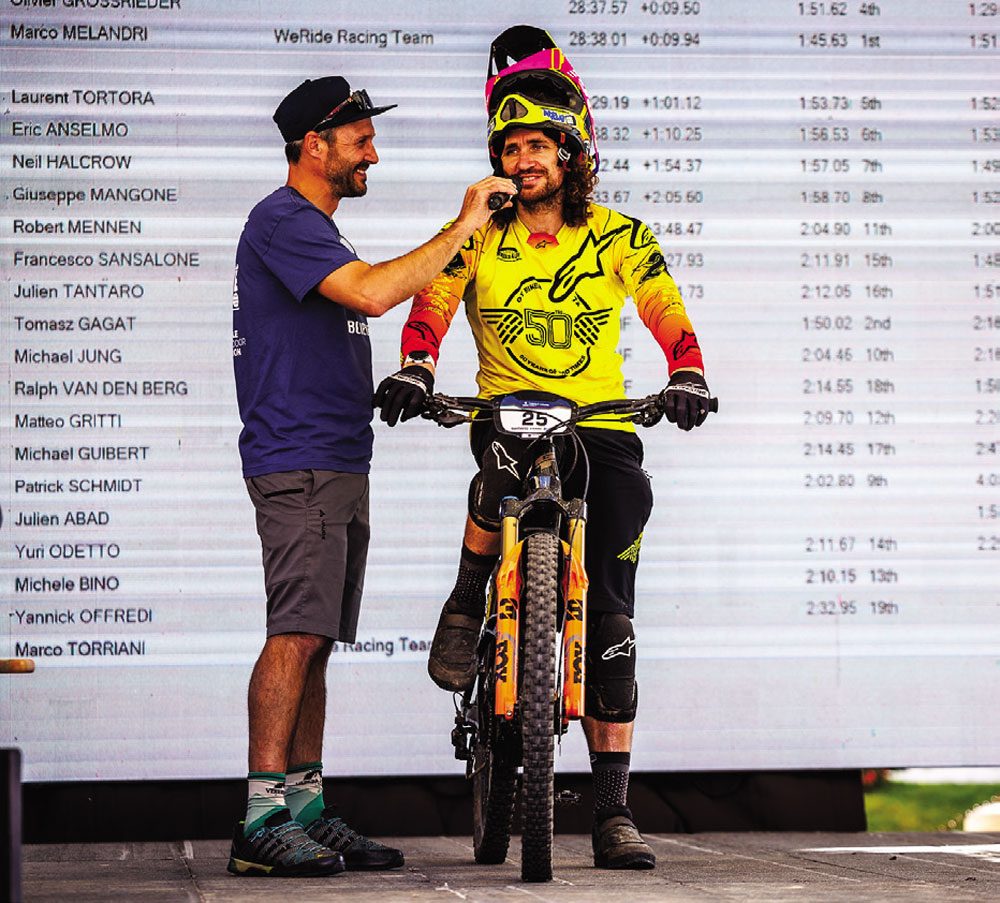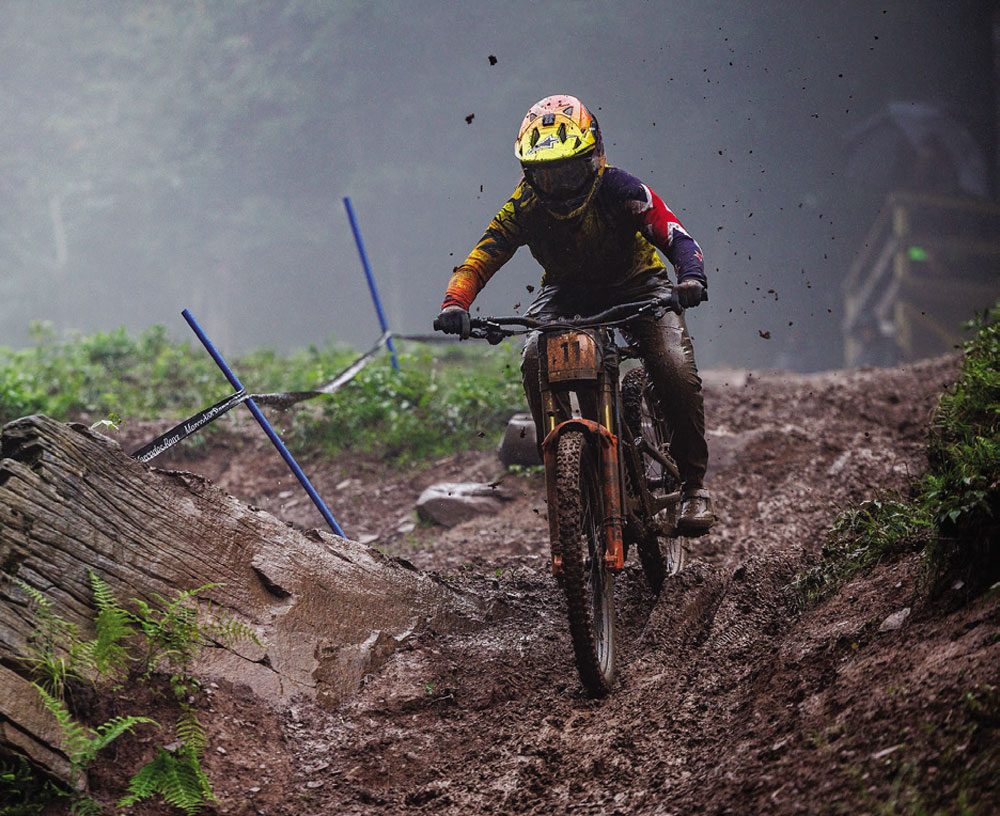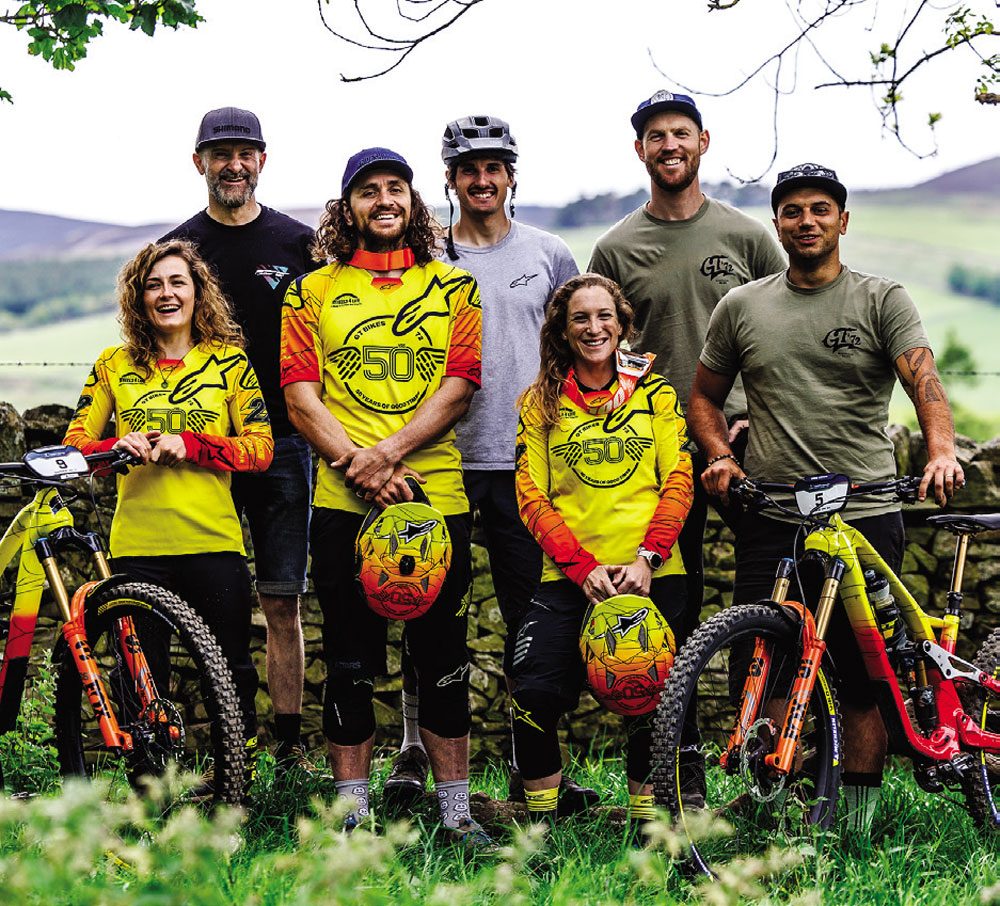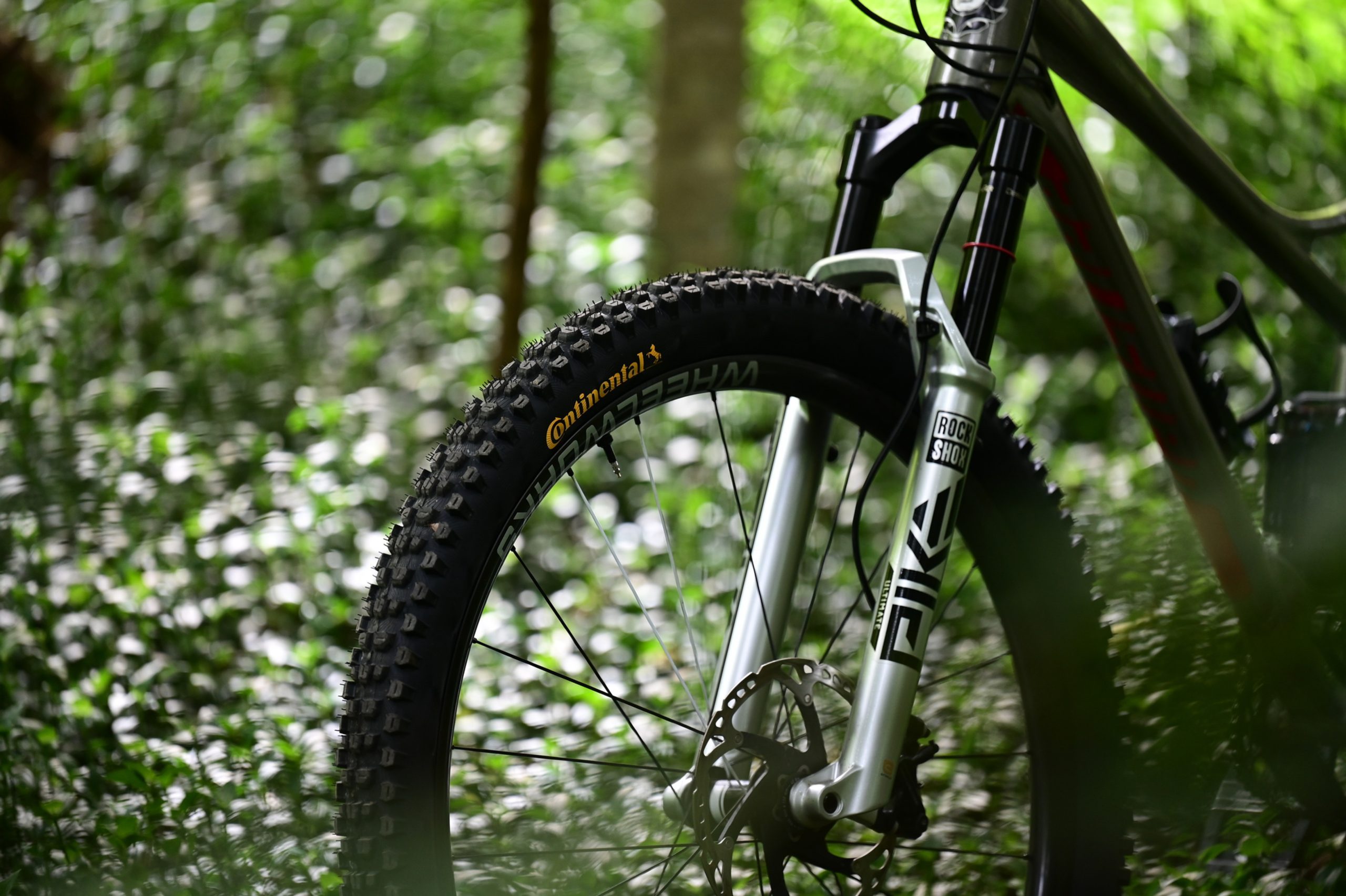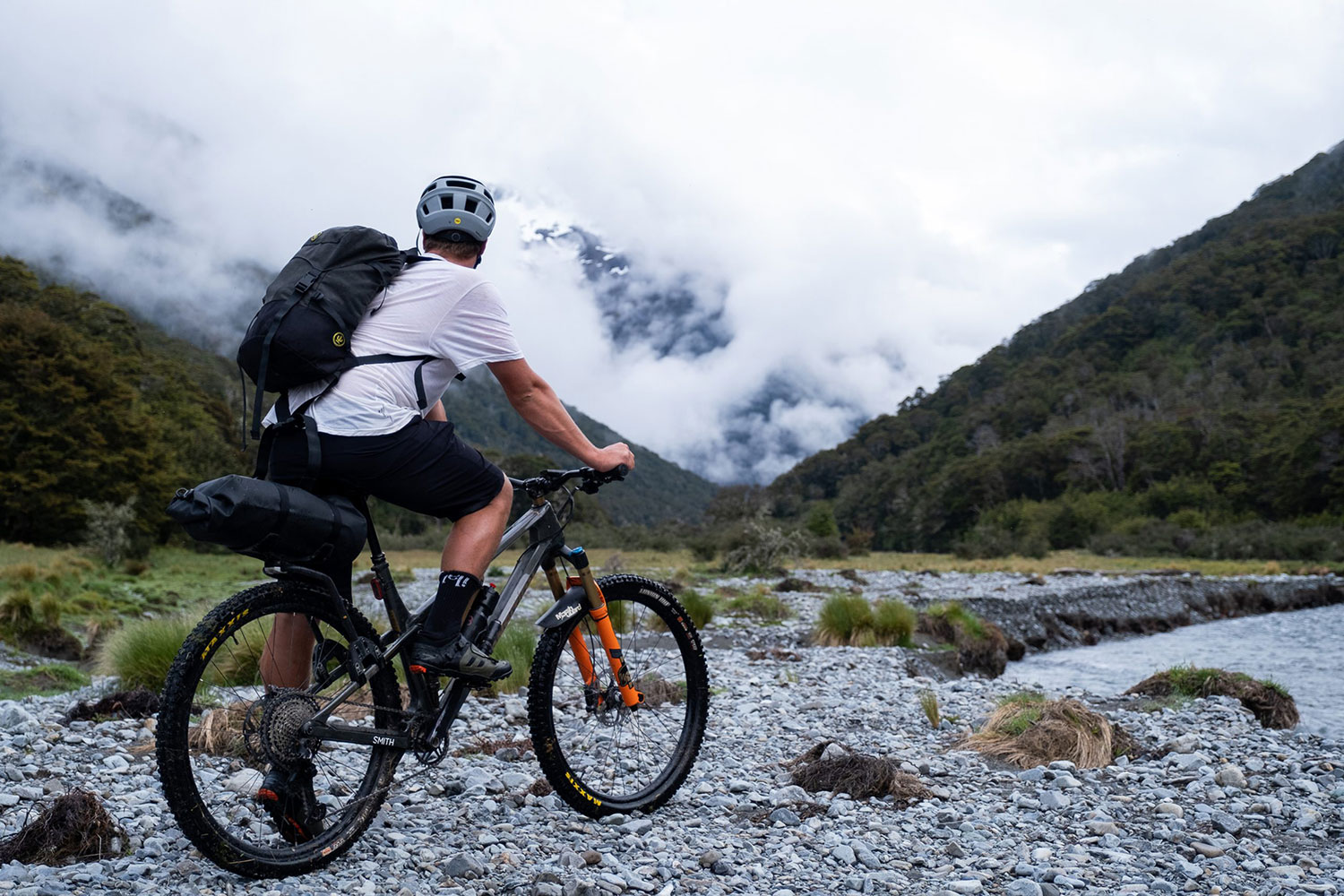An interview with Sam Blenkinsop
Words: Lance Pilbrow
Photography: Cameron Mackenzie & Sven Martin
I’m two minutes into our Zoom interview and Sam is juggling kids on his lap. Prior to this, he’s been on another Zoom, negotiating deals that will form part of his 2023 season. Undoubtedly, his kids will have let his potential sponsors know that Sam, their dad, should really be giving them his undivided attention. But this is the new normal for Sam. The Juggle.
Most New Zealand Mountain Biker readers will be familiar with Sam Blenkinsop in some form or another. If longevity is a sign of success, then Sam could arguably be New Zealand’s most successful downhill mountain bike rider, having been riding professionally for 19 years. He’s been a fixture on the NZ riding scene for as long as many of us can remember. I personally remember watching Sam ride at the 2006 Rotorua World Mountain Bike Championships where he came second in the juniors. I was blown away by how fast he was riding and just how much style he had on the bike — his bike seemed to effortlessly drift through corners, through the air, always slightly sideways, slightly tweaked. Somehow, he made it look more fun than anyone else.
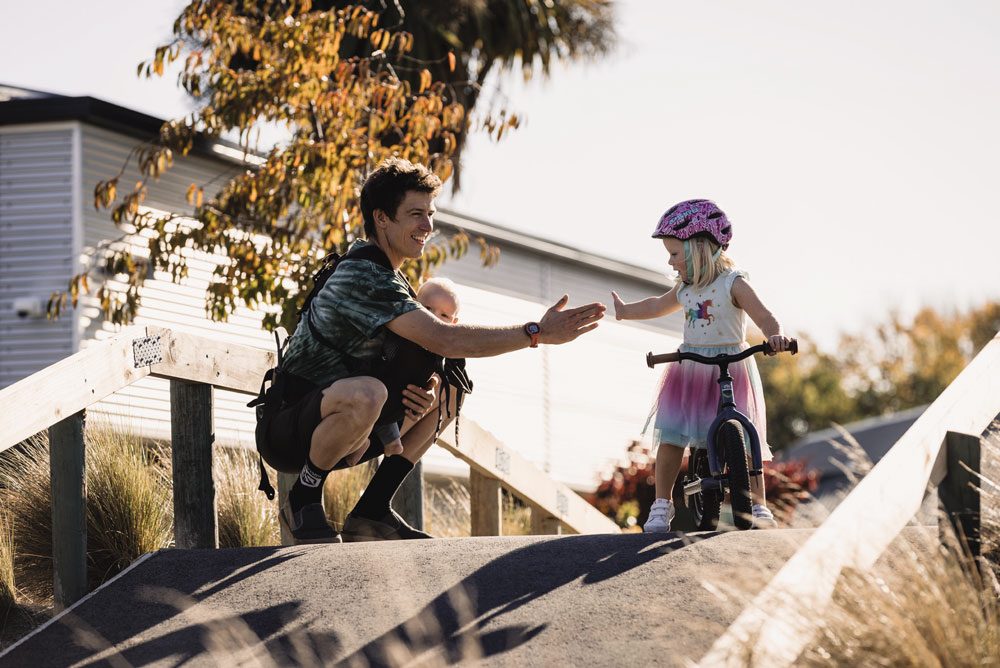
Fast forward to 2022 and Sam is now one of the seasoned veterans on the World Cup circuit. And a lot has changed over that time. Most notably, he now has a wife and two children to join him as he moves around the globe following the UCI circuit. With his experience on the circuit, and confidence to try something different, in 2022, he ditched the established way of doing things, bought a motorhome and hit the road racing; wife and two kids along for the ride too, as support crew. “We purchased a motorhome in the UK, and just drove the whole of Europe,” says Sam. “We did something like 9000km.”
Having recently toured New Zealand in summer with my own family, I’m well aware that life on the road isn’t always plain sailing. The idea of taking a family on the road, managing a race schedule and the pressure of performing at an elite level made me wonder if he’d had a few too many knocks to his head. But he assured me it was fine. How was it for his wife, Lysh, though? “It was hard for Lysh, for sure. She had to deal with our younger one in the motorhome; there is all the feeding. Yeah, it wasn’t aways easy,” explains Sam.
Sam’s kids come in and out of view on his webcam. In the background, I can hear some fighting over toys, and I’m imagining doing all of this inside the close confines of a motorhome — for six months. On the whole, it’s clear Sam, at least, had really enjoyed the past season.
“To be honest, it was awesome,” he admits. “It was just so exciting having the family there. It was like learning a new way of racing; racing while being a dad. It was more interesting than other years because I was going to all these places I’ve been to for 19 years, but I realised I actually never saw them properly. Typically, I’d just be with the team and at the hotel, and I wouldn’t really enjoy the place as much. Now, I’d be at practice, then as soon as that was done I’d go hang out with the family and really enjoy everything. It was great being with them and not just having the race as the only thing. It was like being on holiday with the family, but getting to race too, which was like an awesome bonus.”
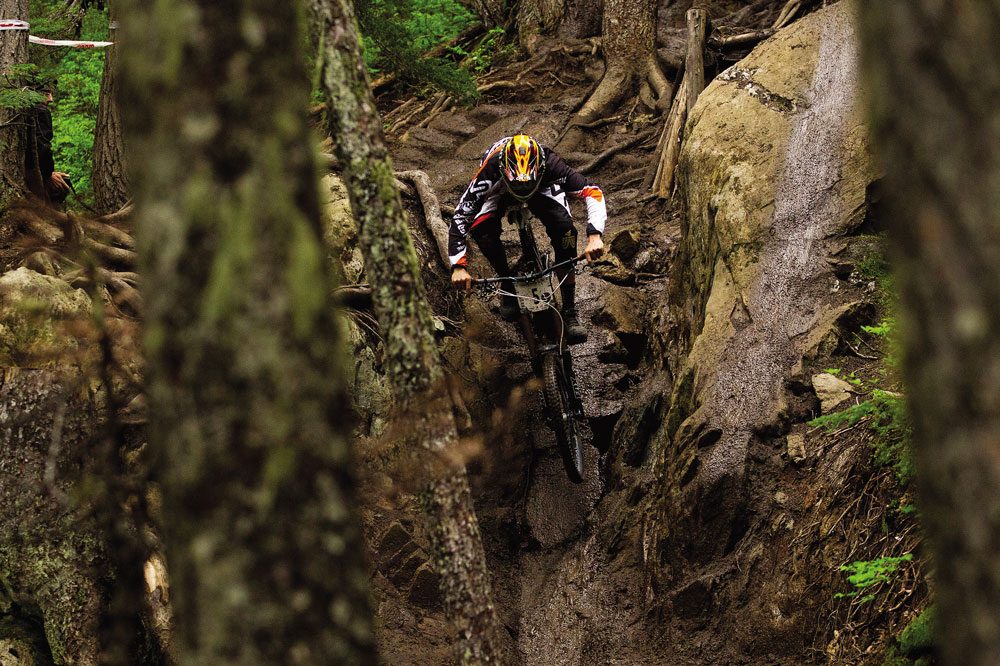
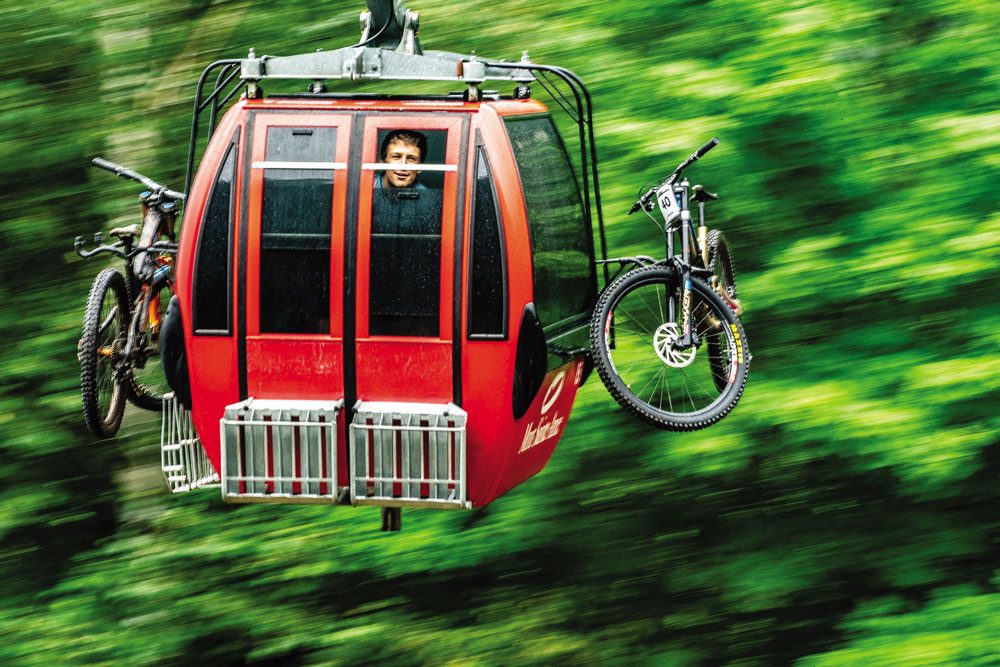
This change of pace seems to suit Sam. The more we talk, the more he seems to relax. He’s reflective on his time as a racer, and the privilege that has been, but also how the reality of being on the road has real downsides. “When you’re with a team, everyone can be in their own bubble and often they don’t really do much. It can actually be quite boring a lot of the time. It’s crazy!”
But he hasn’t always been this way, and he seems to be able to see his own evolution and maturity as racer. “When I was younger, I was more like how I see other younger racers now — it was just racing, racing, racing! Everything had to be absolutely perfect.” He laughs, seeming to sense a bit of irony at what he is saying. “But now I’m old!” I’m a little surprised at just how casual he seems about it all, he just seems to be more realistic. “I just feel like I know what goes into racing — what works and what doesn’t. But actually seeing places differently, that’s what changes when you become a parent. It’s interesting in new ways,” Sam laughs. “Now I’m just looking for the best playgrounds and parks!”
But despite the highs of having his family on the road with him, the challenge any professional athlete faces is that results still matter. So, I asked him if he had achieved what he wanted to this year? “To be honest, my race results weren’t where I wanted them to be. It was pretty frustrating,” Sam admits. “I would get a mechanical or a flat tyre, it was… annoying.” Fort William was one such race. He missed out on qualifying for the main event, a race that is usually one of his favourites and one he performs well on. “I got a flat tyre halfway down…. I missed out on qualifying by half a second.” This was a tough pill to swallow. “I hadn’t been that angry for a long time. We’d driven all this way, I’d been with the family, it was a week of shitty weather, everyone was cooped up in the motorhome, there were midges everywhere, kids couldn’t do anything.” I ask him if having his family there changed how he was able to cope with a disappointing race. “Having the family there changes everything. In the past, if I was at a race and I didn’t do well, I would be thinking, ‘man I wish I was at home’. But, with the family there, it was completely different. It was just like, ‘ah, it doesn’t matter, it’s just part of it’.” This family thing sounds like the ultimate racer’s edge: great support when things are tough and the people you most want to celebrate with when things go well. Like at Mt St Anne, in Canada, where he was back in the top ten: “The high of that whole weekend was really just having the family there with me. It was just the best thing ever.”
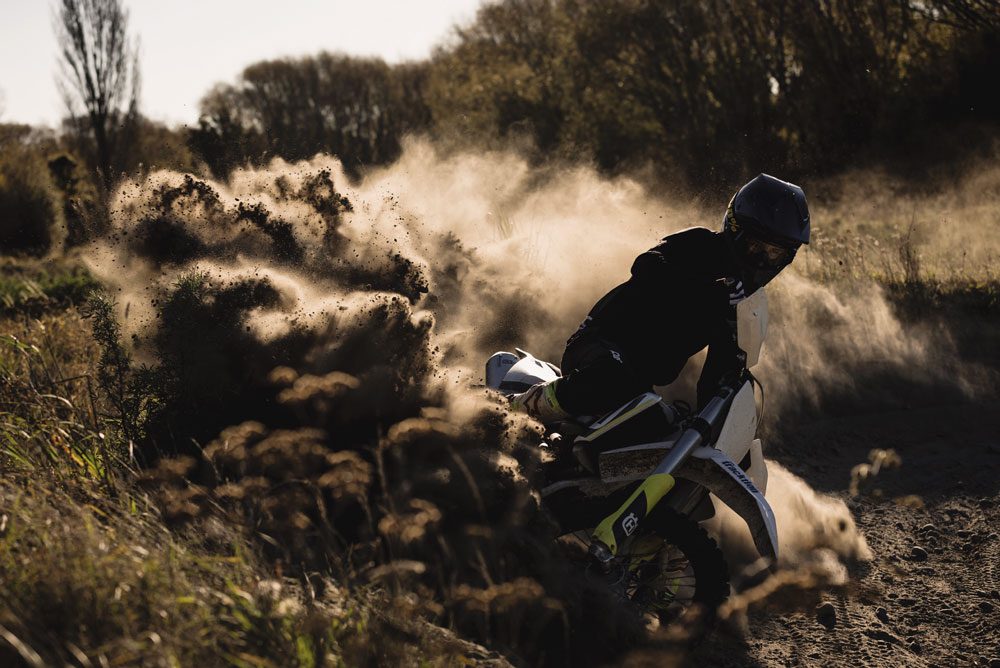
Sam seems to have been able to carve out a career as a racer that is pretty enviable, and the longevity of it all is unique. In fact, just staying healthy in a high risk sport like downhill is a challenge; always balancing risk and reward. “When I was younger, I just wanted to go as fast as I could,” says Sam. “But you figure out pretty quickly that it doesn’t really work well that way. You just can’t ride that way all of the time, ‘cause you just end up crashing.” I ask him if this is, however, just what is required to be at the very top? He agrees. “Those guys [Loic Bruni and Amuary Pierron] just ride at such a high level. The risk is so high. But, if anything happens, when they hit the ground, they’re done, the season’s over. I can ride at that pace too, but it’s risky. You need to be comfortable with it.”
Staying healthy, staying on the bike, and showing up to races year in, year out has helped Sam keep sponsors happy. He has just finished up a contract with Norco, after seven years working together, to explore something new. Now, he’s taking charge of managing his own sponsors and race schedule. This seems like a lot of work to me; I ask him why he’s doing it? “I always wanted to run my own program, and I’m finally getting a chance to do that. I feel like I’m going back to my roots — not like a privateer, I’ll have factory support and I’ll have a good budget — it’s just a simpler operation.” Being on the Norco factory team, Sam has seen it all. It’s big business with big overheads. “In a big team, the team takes everything you make them. The managers get paid because of you; the budget is massive to move a team around. I realised this year, in taking myself on the road, it just doesn’t actually cost that much. But, with a team, you’re spending so much money with hotels, mechanics, managers and different staff. The amount of money that gets blown is unreal. With Norco, about twenty people were involved with the team; mechanics, ex riders, masseuse, other staff, an on-track guy.
They were a Canadian team, so lots of them would go to the race and then fly back to Canada each week. The amount of money that got wasted… I couldn’t believe it. So I just knew I could do something simpler that would still allow me to make it work.”
Sam seems to be confident in his own experience. Confident he’s developed skills he can now use to help navigate the new reality of racing whilst also being a family man. “I’m excited about the direction I’m going in, I really feel I can be in the top 10 for sure. I still believe my riding is at that level. I still feel like I can be on the podium the weekends that the track suits me and I’m feeling good.” But the sponsorship side of things is a steep learning curve. “It was so much easier when I had a manager doing all this! Now it’s way harder. I’m just not used to doing it. I’m so Kiwi! We just don’t say, ‘I need this much money so could you please give it to me?’. We’re more reserved and sort of just end up asking for something, anything. Often, I’ll say a number and sponsors will be come back to me with; ‘we can do more than that — you should really be asking for more!’ So, I’m learning I need to be a bit more cocky really. Sponsors often have more to offer than I think they do. But I like that I’m learning all this.”
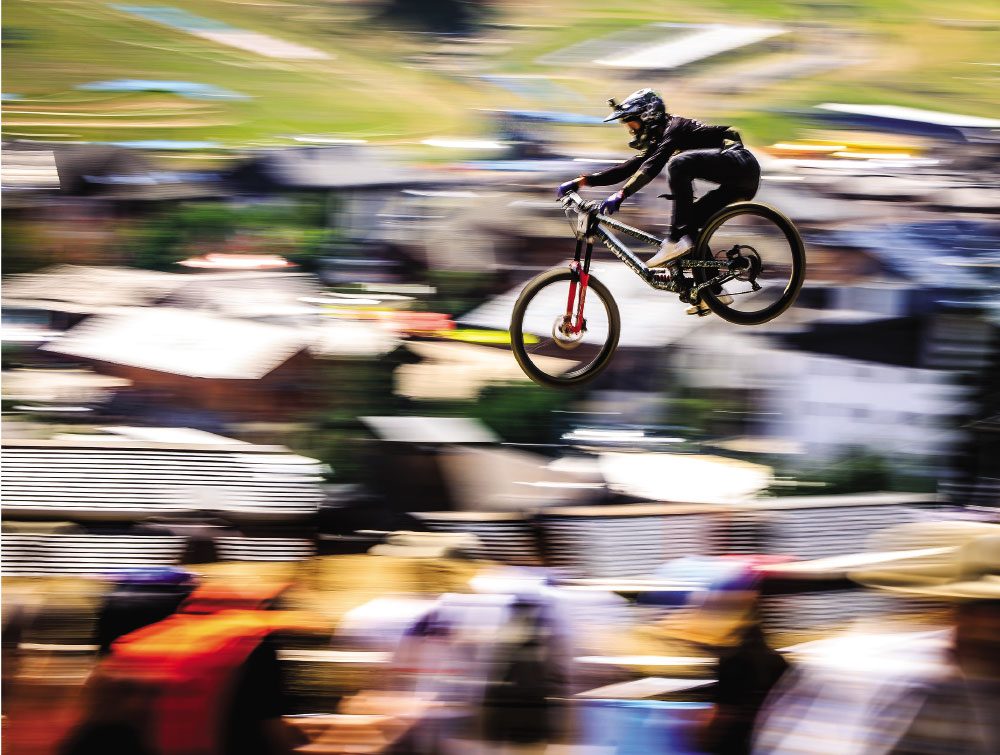
Taking charge of his own program is about creating new opportunities. For example, he’s getting to work directly with the brands he has always wanted to work with, and working with them directly instead of through a manager or a team. “So often I’m hearing the brands say how good it is to be dealing with me directly. They’ll tell me they’ve always wanted to work with me, not this other person or a team I have been associated with. Often, they just want to do a little deal with me directly but they’ve had to negotiate with the whole team. So it’s cool to be able to work more directly with the actual companies and hear this kind of stuff.”
It’s not all plain sailing, though, and even trying to ensure he gets enough support to run the lean operation that he has in mind for next year has challenges. “It’s hard at this time, all the sponsors are tightening up. They’re not selling as much and everyone is overstocked, and everyone’s freaking out, and just taking so long to return calls and emails.” But Sam’s confident it will all come together, and he’ll be back on the circuit next year. He won’t tell me what bike he’s riding just yet, but he’s obviously excited about it. “I’ve pretty much got everything locked in but there are still a couple of things we’re waiting on. In terms of the industry, to be honest, it is probably the worst time to do it.” But he’s enjoying the new challenges of management, and of the conversations he is getting to have. “It’s just great to be able to choose the people I want to work with, and work with the people I like to work with. Everyone that I’m working with is a friend; I’ve worked with them for years and they are fans of me and I feel like I’ll be able to have a long future working with them. I was with Norco for a long time, and a part of me was just thinking, ‘this would be good if it carries on forever’, but in other ways a fresh start is exciting too.”
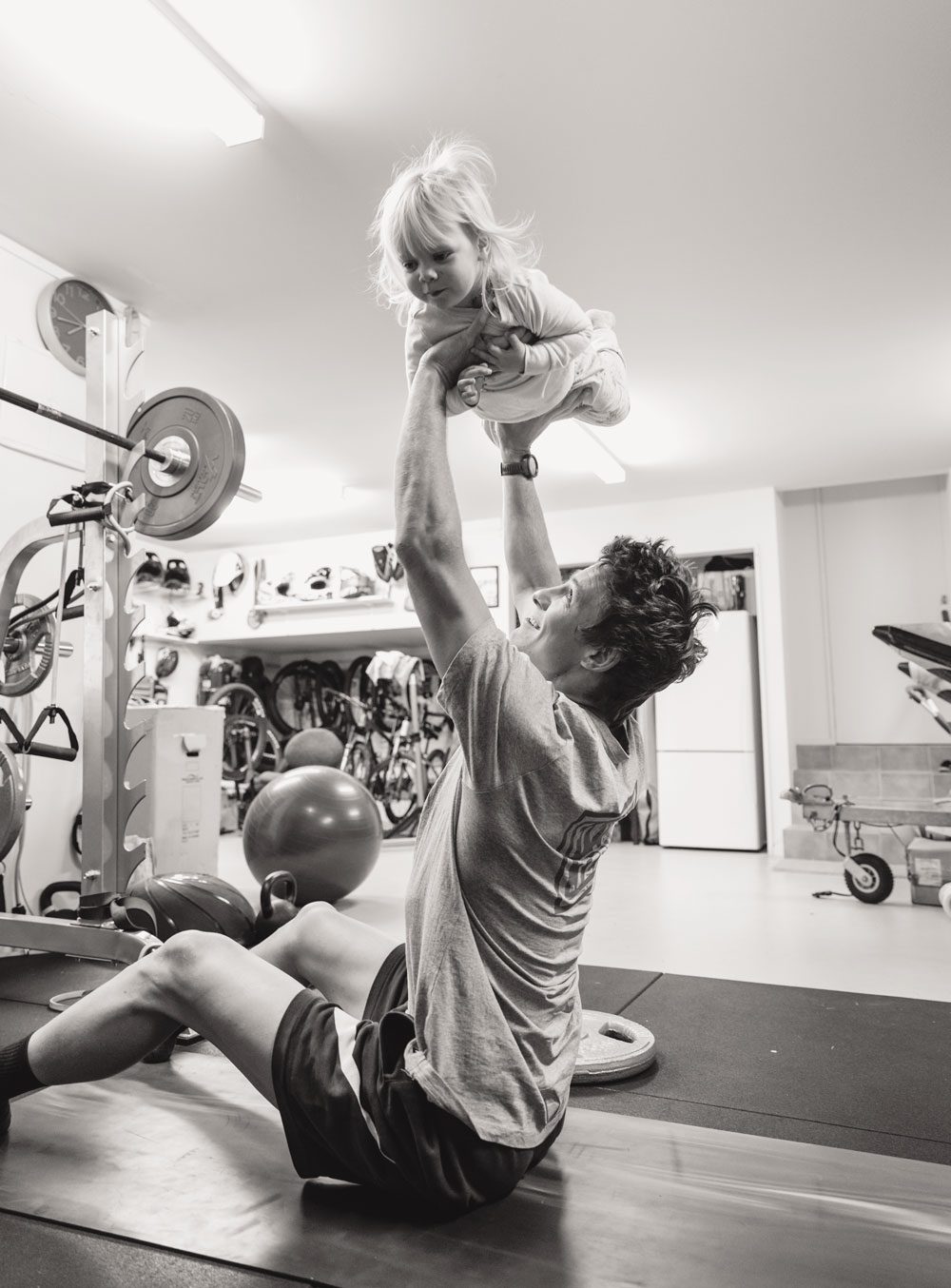
There are other changes on the horizon, too. Not least of all Discovery TV taking over the broadcasting rights to the UCI Mountain Bike World Cup. Something that has a lot of riders, Sam included, curious to see how it all unfolds. It’s a complicated business working with the UCI, and the relationship between the UCI and riders has often been fraught. Plus, there are lots of unknowns. “We don’t even know how many people are going to qualify; how many people they are going to show on TV… It seems like they are trying to suck every cent out of us,” explains Sam, candidly.
On the other hand, Sam has always been a fixture on the Crankworx schedule, something some of the other riders don’t seem to prioritise. The reason is simple; “I’ve just always enjoyed the Crankworx events,” says Sam. “If you go to a UCI World Cup, the organisers don’t really care about you at all. You are the show, but they just aren’t bothered. The Crankworx guys, though — you go to the race, and they do everything for you. They are so supportive of you; they help you out with everything. You email the organiser and ten minutes later you’ve got an answer. They just really take care of the riders.” And the festival-style race schedule appeals to Sam, too. “All the events are so fun. They just pack the events in, too. You do one race one day, and if you do badly in that one race, you’re like, ‘oh well, I’ve got another race tomorrow’. It’s busy, and I like that. At Rotorua this year I had the downhill practice, slalom and pump track all in one day. The people love it. I’ve always told the organisers I’ll race these ‘til I can’t race anymore.”
Right now, however, it’s the off season and, for Sam, this means it’s time off the bike and a different pace of life. “I drop my daughter (Indie) at pre-school, then I take Blake (his son) for a spin in the bike trailer.” Family commitments mean Sam doesn’t have the luxury of training whenever he wants, either, so he’s being more efficient than ever with his time — doing weights in the garage before the children wake up being just one example. But his off season is more than just being off the circuit, its exploring other passions too. “I love hunting and spearfishing and that’s what I love doing when I’m not racing. This time of year I love those things even more than biking… Racing is so intense, but with diving you’ve got to really slow your heart rate right down and be relaxed. Plus, it’s all about just being in another environment. Hunting is the same, you have to be calm.”
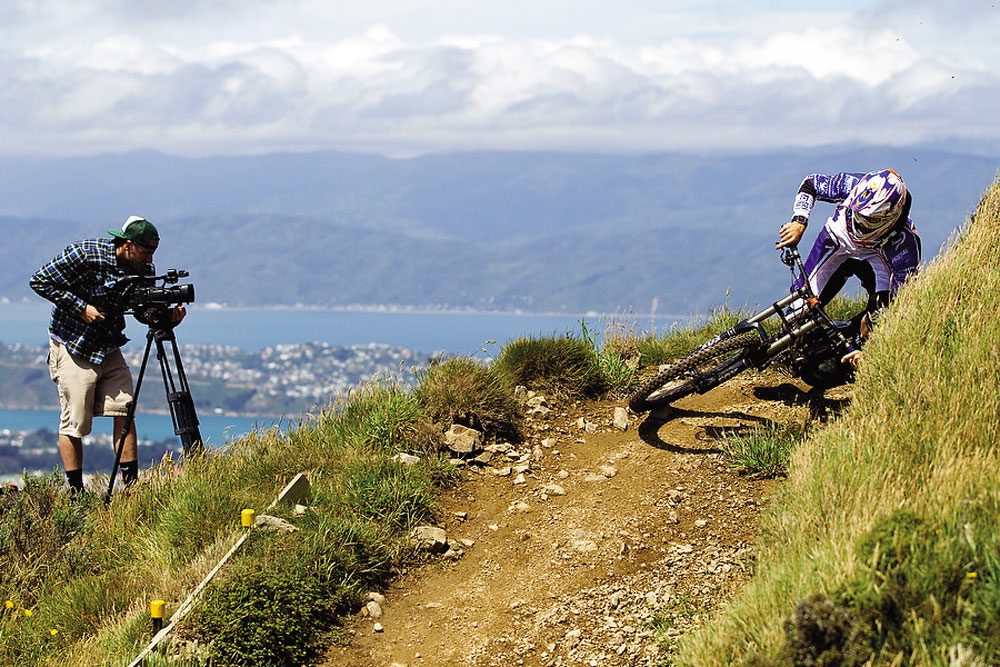
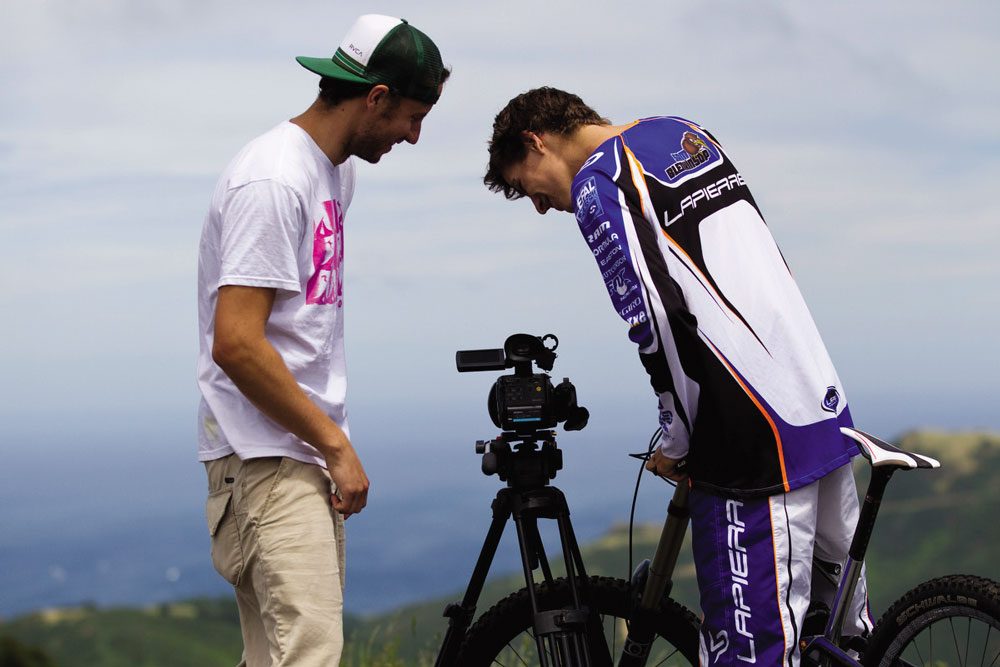
Nineteen years in any career that takes you on the road for six months of every year is a challenge that could wear thin, but it seems to suit Sam just fine. “I can’t stay in one place for too long. I don’t know how people live in one place for so long! After being in Christchurch for seven months, I’m ready to go back to Europe and start racing again. I just – still – love racing. That’s what I realised this year; I just love racing.” I ask him how he’s stayed in the game for so long, and how many other riders he seen come and go, and his answer reminds me of the day I watched him race in Rotorua: “I think it’s just because I enjoy it so much”. We talk about this for a while, and Sam mentions that one thing he’s wondered about is whether his ability to really enjoy life off the bike has helped him enjoy life on the bike even more. “I think, guys who didn’t stay in that long, all they did was ride their bike. I think if you’re just doing that all the time, you’ll get over it. It’s almost like they’ve put too much into it. To be honest, in my off season I hardly ride a bike. I just do other things – hunting, fishing, diving, and spending time with the kids. Just having other things going on aside from racing is so important.”
Sam acknowledges it hasn’t always been this way. Without being arrogant, he seems proud that he’s been able to evolve over the years to approach riding in a more mature way. “When you’re young you need to be on the bike all the time, you need to do that to get the skills and that’s exactly what I did. I just rode my bike every day, did dirt jumps, pushed up to do downhill runs, XC — whatever I could do. I spent every day on my bike, from dawn ‘til dusk. It was all about biking. But now, I know I’ve got those skills, so it’s more about having fun on the bike and enjoying it and not getting burnt out. It’s key to know when to train and when to stop – to avoid getting burnt out with training. It’s a learning thing — and I’m still learning.” He seems genuine. Genuine that he really does still just love riding his bike, but hungry for more too. “I feel like I’ve got a lot more in me. There’s a lot of young kids coming through the local scene, but they don’t seem to be able to beat me yet, so I might as well keep going.”
Might as well.
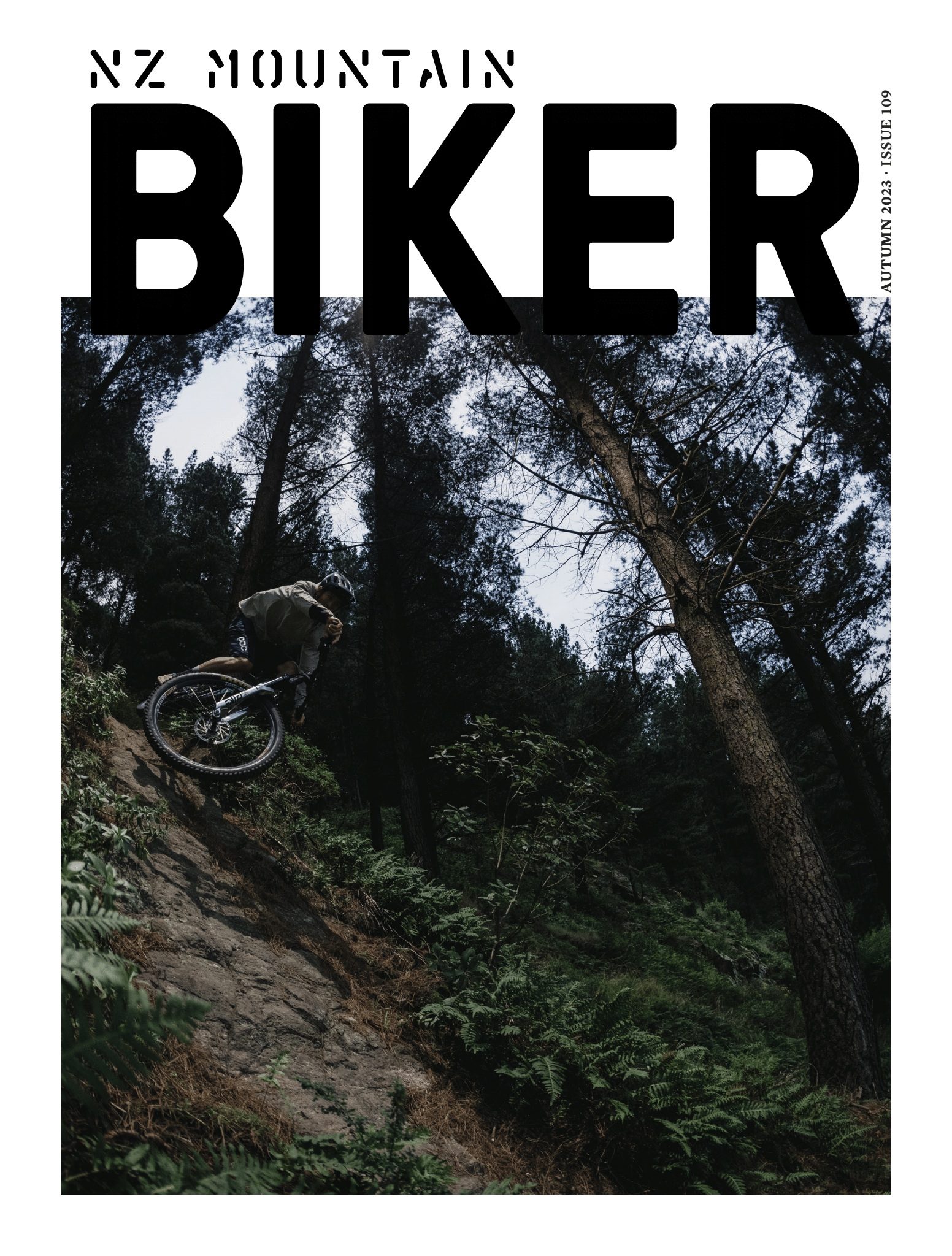
A year in review: A team manager's perspective - Behind the tape
Words: Cam Cole
Photography: Sven Martin
Winding the clock back, I started in the role of GT team and performance manager back in November 2021. This opportunity emerged while I was attending the 2021 UCI Mountain Bike World Champs in Val Di sole as the stand-in New Zealand team manager while our borders were still virtually closed, in the middle of the Covid pandemic.
The 2022 northern hemisphere summer has been and gone. In fact, it’s now well and truly in the rear view mirror. For me, in a diverse role supporting GT Factory Racing (GTFR), this came with thanks after many long days spent track side, pointing at riding lines scattered with rocks, roots, dust and mud; being holed up in event villages running errands, cooking meals, making coffee, setting up team pit infrastructure only to tear it down again; travel days navigating narrow Scottish roads in long, heavy team vehicles, attempting to peel tyres off rental cars, boarding ferries and flights spanning oceans, countries and continents; and of course, in classic GT Factory Racing style, our fair share of good times. After an opportune catch up with some old mates from my days as a professional rider (that’s a story I will save for later) some ideas were thrown about and a couple of months later I was signed on to the team. Soon enough, I was buried in online meetings, planning the 2022 racing season, and numerous spreadsheets as the management staff ground through all of the leg work that would allow the team to operate during the 2022 racing season.
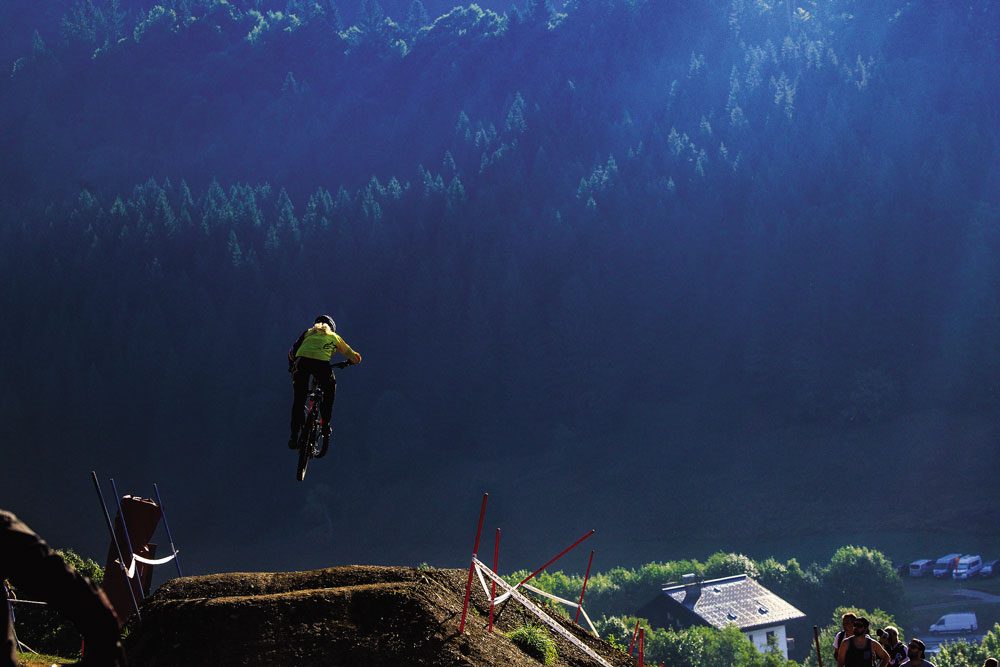
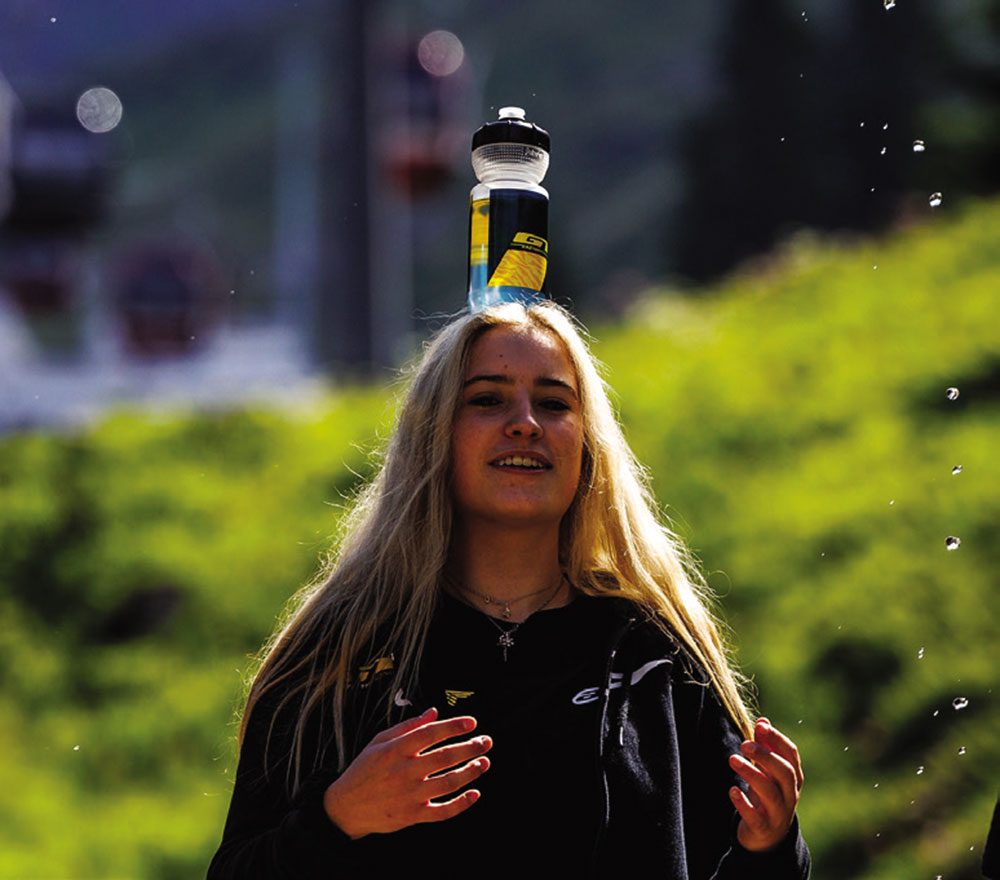
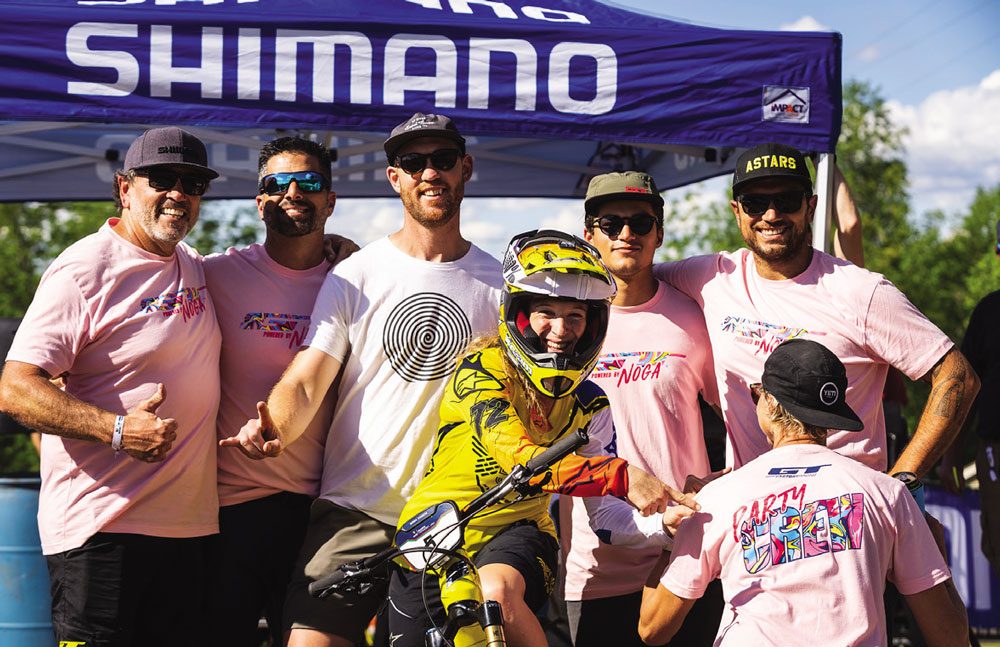
Team and Performance Manager — an ever-changing role
The role I’ve taken on with GTFR is a diverse one. It’s a role that evolves in its nature depending on the time of year. In the off season months, it looks and feels like any administrative role. Duties include event planning: from building out the team calendar for the season, booking flights and accommodation, all the way through to working closely with the chef team that supports us at the World Cups. On the performance side, I am frequently in contact with the riders so that the team is updated and aware of their off season progress and so we can keep them updated on any news coming from GT HQ or team partners. On this aspect of the role, my experience as a former professional rider is valuable in ensuring the riders are supported and that the team can assist them in their professional and athletic development. Ultimately though, the athletes on the team are highly motivated and require only guidance as we work together to refine their approach to top level international racing. On the marketing and business side there are general communications aspects of the role, to ensure info is flowing in all directions between the team, several of the GT business functions and GTFR team partners. In addition, there is budgeting and budget tracking. During the off season months, I work closely with Steve Spencer on the sports marketing side at GT HQ and Mark Maurissen, who works on the product and tech side for the team, taking care of all product ordering and allocations for the team as well as supporting the logistics planning. During the season, Mark is both a mechanic and logistics operations support. Additional staff include Rich Simpson, based in the UK, Matteo Nati, who divides his time between Italy and New Zealand, and our two French media mates, Louis and Jules. During the racing season, my job morphs into more of an operations role as the season plan rolls out week by week, race by race. The hours stack up quickly with early mornings in the pits helping the mechanics set up for the day, and generally end late with planning for the next day and site clean-up. Energy is what you need for this part of the job, especially since we are a relatively small factory team and one of only a few that compete in both the Downhill World Cup and Enduro World Series (EWS). For most of the Downhill World Cups in 2022 we were four to five staff looking after four riders, compared to the likes of Commencal Muc-off who have upwards of 10 staff for four to five riders. My days at the events are stacked with general race and team admin, such as assisting with the maintenance of team equipment and supplementary grocery shopping. On the performance side, it becomes more intensive at the events, ensuring riders have what they need to do their job well. The on-track support for the riders is a big part of it when I’m at the races. For DH that means standing track side sighting lines, coaching or suggesting racing tactics and strategies. Sometimes communicating with mechanics about bike set up is required. During the peak of the season sometimes all we can do is react. Dealing with cancelled flights (thanks Easy Jet), adjusting race plans as the inevitable injuries pop up and just generally rolling with the punches that are thrown at you daily when you are managing a dozen people traveling and racing all over the world is par for the course.
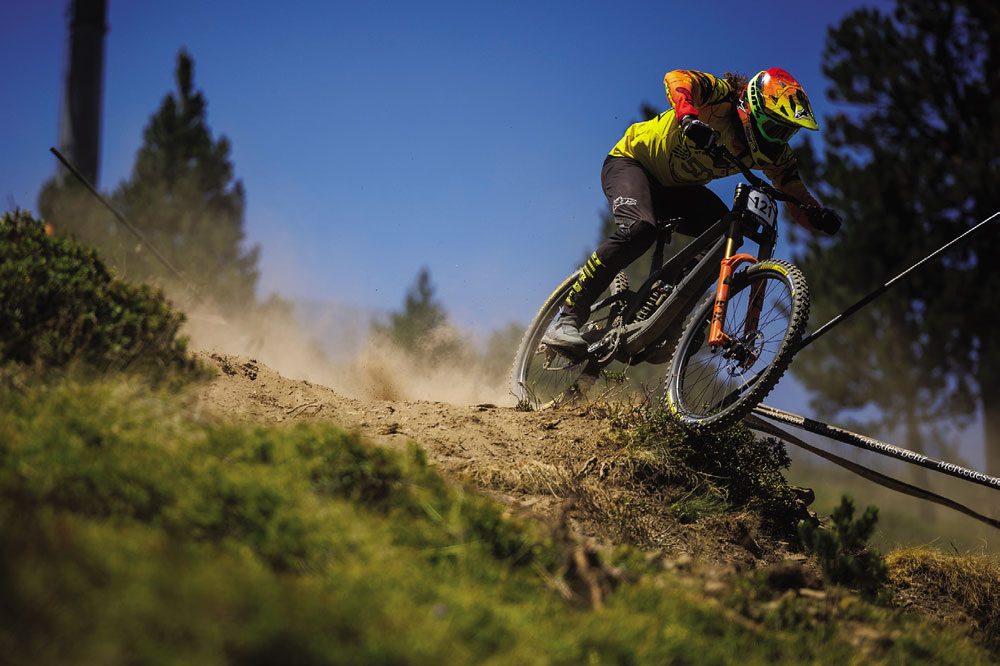
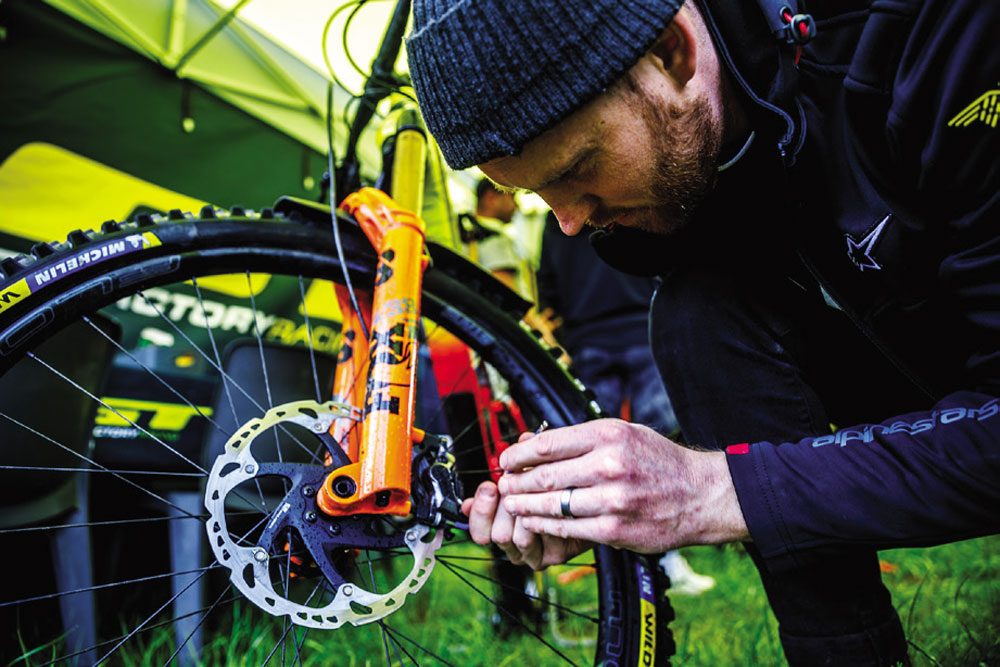
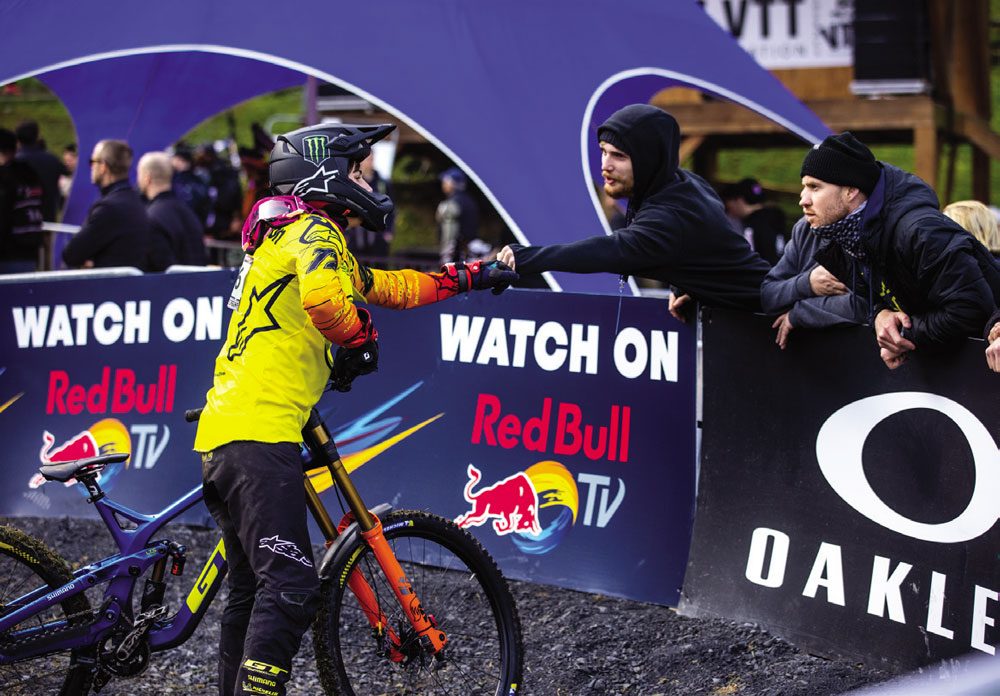
The Racing Season
Soon enough, the 2022 racing season was underway, and we were on the ground putting plans into action. We kicked things off in early March ’22 with a preseason block of training and racing in bitterly cold central southern France, before heading further south into Portugal in search of a little bit of sunshine to boost the mood prior to the unusually early start to the Downhill World Cup season, in Lourdes. At this point, we were still missing Jess Blewitt from the team, due to her delayed return to international racing after taking the entire New Zealand summer off to ensure full recovery from the injuries she sustained at the 2021 World Cup finals in Snowshoe. Nevertheless, we still had a strong group of riders in Ethan Craik, Ryan Pinkerton and, of course, none other than Wyn Masters. Although highlights of this first block of racing included all riders making the podium at a Portugal Cup downhill race, and sucking on juicy Portuguese oranges, the Lourdes World Cup was a reality check. This race showed us the brutal nature of World Cup Downhill racing both in terms of the course and quality of the athletes. For round two, in Fort William, we would have all of our riders on an updated version of GT’s downhill bike. This, along with a revised focus after Round 1 and having Jess back on board, was a huge boost for the team and paved the way for several substantial steps in a positive direction. Despite Jess picking up a small fracture in her collar bone, her pace was on target for a solid result and Ethan was riding on pace for a top 10 – 15 result until he unluckily misjudged a heavily degrading corner and fell victim to the wet and windy Scottish conditions on finals day. The Enduro World Series season kicked off on the first weekend of June, two weekends after the Fort William Downhill World Cup, so after a short breather I joined the Enduro team in Innerleithen, Scotland. Although we didn’t come away with the comfort of knowing our outright race pace matched that of our competitors, we did maintain a positive and ‘can do’ approach to picking up the pace up throughout the season. Sometimes, things just don’t go your way in racing, but the only way forward is to reflect on a situation and truthfully answer any questions that the facts present you with, in any situation you find yourself in. Having been a professional international racer myself, from 2006 – 2014, I understand the pressures and demands the riders and teams face. I have had many successes at the top level of the sport. Many of those have come after times of truthful self-reflection and facing the ‘no blame’ facts presented to me. These were often that I was not prepared to race at the highest level due to physical, mental or emotional shortcomings, or that I was just not executing my races in a free and relaxed state. This was true for the Enduro team. There was no flow happening both in and out of the events. Things were just not happening as easily as they should have been for the quality of the team we were on paper. The struggle continued into rounds 2 and 3 of the World Series, in Slovenia and Italy. Noga Korem looked like she was riding well on track, but was just not feeling completely confident at full race pace. Katy Winton was in a similar position, but was feeling like there was something deeper at play holding her back. After fighting through an entire season as a privateer in 2021, her efforts to get to this point in mid-2022 – and back on a factory team – were becoming too much to sustain the detail-oriented approach that is required to maintain the level of performance Katy and the team expected. So Katy bravely made the decision to suspend her racing season so that she could take some time to reflect and dig into what factors were holding her back. With the first major travel and racing blocks of 2022 under our belt at GT Factory Racing, we had forward momentum on our side regardless of the positive or negative nature of the situation. I personally find it better to at least know where you stand and from that point feel equipped with the facts so you can address the situation as it presents. After the Val di Fassa EWS round there was a week break before we faced nine races in nine weeks through July and August, across both the EWS and World Cup Downhill series. This included the Lenzerheide, Andorra, Snowshoe, Mont Sainte Anne and Val di Sole World Cups, and the North America triple of EWS races, as well as World Championships in Les Gets, France. Highlights from this intense string of racing included Jess’s first Elite Women’s World Cup DH podium in Andorra, which she promptly followed up two races later with another fourth place. Jess rounded out the season strongly by achieving another podium place finish at the World Cup finals in Val di Sole, on the most technically and physically demanding course of the year. Ethan, in his first year as an elite male, also achieved a career first when he placed seventh in his first elite Top 10 at the Mont Saint Anne World Cup, and was showing serious speed at the World Champs until a crash on the morning of race day slowed him down substantially. Finally, Ryan Pinkerton rode to a solid second place at the World Cup finals, topping off his first year in the junior ranks. But, if you think it was all champagne showers for the team, I should mention a challenging travel day from Washington Dulles airport after the Snowshoe World Cup, to Mont Sainte Anne for the following race. The day started early with two flights from Dulles to Quebec, via Toronto. When we arrived in Quebec we found the rental car company had cancelled our reservation and permanently shut its doors, but had decided they didn’t need to let us know about it. Since many of the World Cup Downhill and Cross Country teams were flying into Quebec City airport at that time, there was no chance of any rental stock being available that would allow us to move seven people around Quebec and Vermont for the following two weeks. In the end, we decided to fight that fight another day. After taking taxis to Mont Saint Anne, we sat at one of a few local restaurants and ordered dinner – which took forever to reach the table. After a late finish to the meal, we decided it was time to check into the two apartments I had booked for the week. The check in process ended around midnight with Mark breaking down a door to one of the apartments as the digital panel controlling the lock had failed. With that, you start to understand the mental approach and skillset that is required when being part of a team of 12 people who for five months of the year are constantly on the move and not always in the same place, let alone the same time zones. By mid-September, there were just the final two EWS races remaining in the 2022 international season for the team. For these last events we were still missing Katy, but through her time spent away from the races, reflecting, she was beginning to see the early steps required to return to racing at the top level. With the support of GTFR and her immediate support team, she was regaining the fire and energy it takes to ride a bike fast and to one’s potential. In terms of outright results, Noga finished the season very strongly by placing fourth at both the Crans Montana and Loudenvielle races, and was once again having fun at the races and on her bike. This was a relief for her and the team. Ultimately, I do this because I enjoy the process of learning and striving for performance but what really makes it so good is seeing the riders expand their personal horizons and have fun racing their bikes.
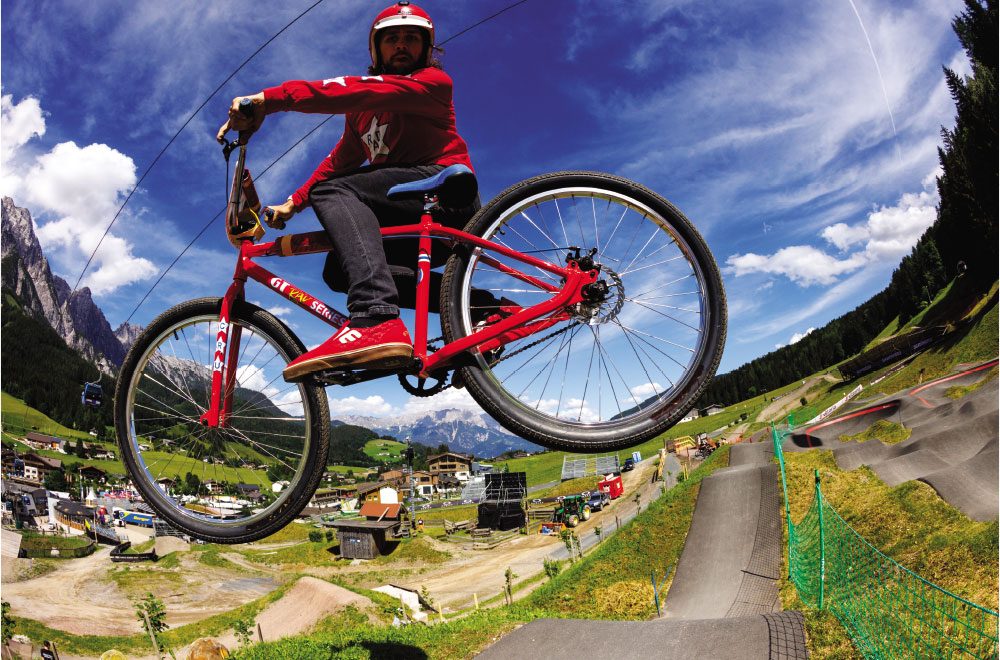
Reflections
Since the end of the season, after the final EWS race in Loudenvielle, we have had the chance to back off the gas, unwind and spend some time recovering physically and mentally. However, for those at the sharp end of this business, this time of the year is utilised as a chance to reflect on the past season while it is still fresh in the mind. While it is a good time of year to catch up on any night time reading that is missed during the season, it is also a chance to take notes and brainstorm new ways of doing things, that could be implemented in order to improve performance. Since the end of the 2022 season, we have already overcome some of the challenges that presented themselves over the year. But, we have many more ahead of us. For me, this is the lure of being part of a team competing in the highest level of competition, in any context. No matter what the result, there is always more to be improved on. Competing in an environment such as this forces teams through a process and journey of improvement. You don’t have a choice if you want to remain competitive in this game. Looking ahead to 2023, it’s going to be another busy year. Although there are still many months until the Downhill season kicks off, the first EWS races take place at the end of March, in Tasmania. So, for me, it’s swiftly back to the usual off-season duties.
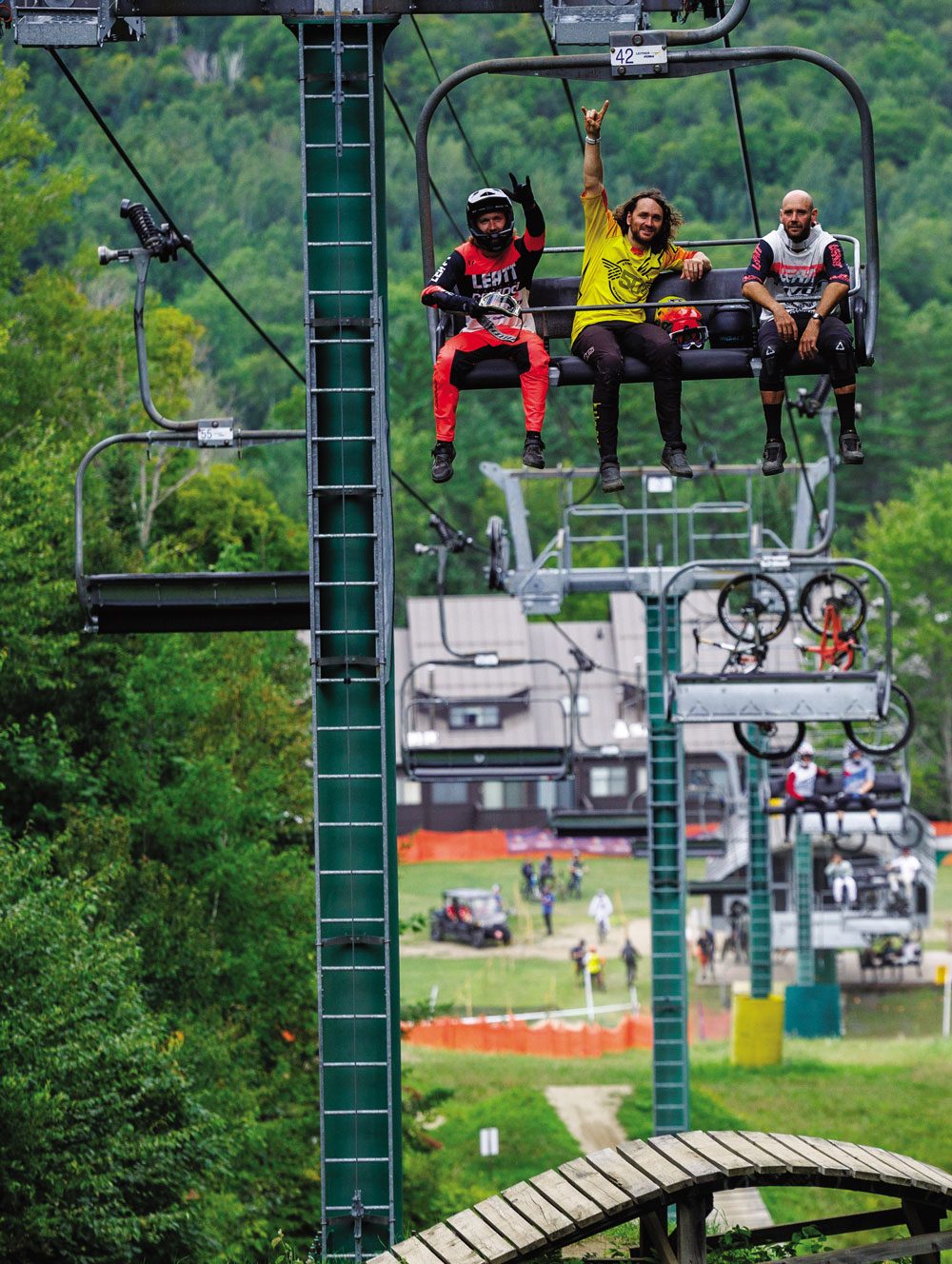
ENERGY IS WHAT YOU NEED FOR THIS PART OF THE JOB, ESPECIALLY SINCE WE ARE A RELATIVELY SMALL FACTORY TEAM AND ONE OF ONLY A FEW THAT COMPETE IN BOTH THE DOWNHILL WORLD CUP AND ENDURO WORLD SERIES (EWS).
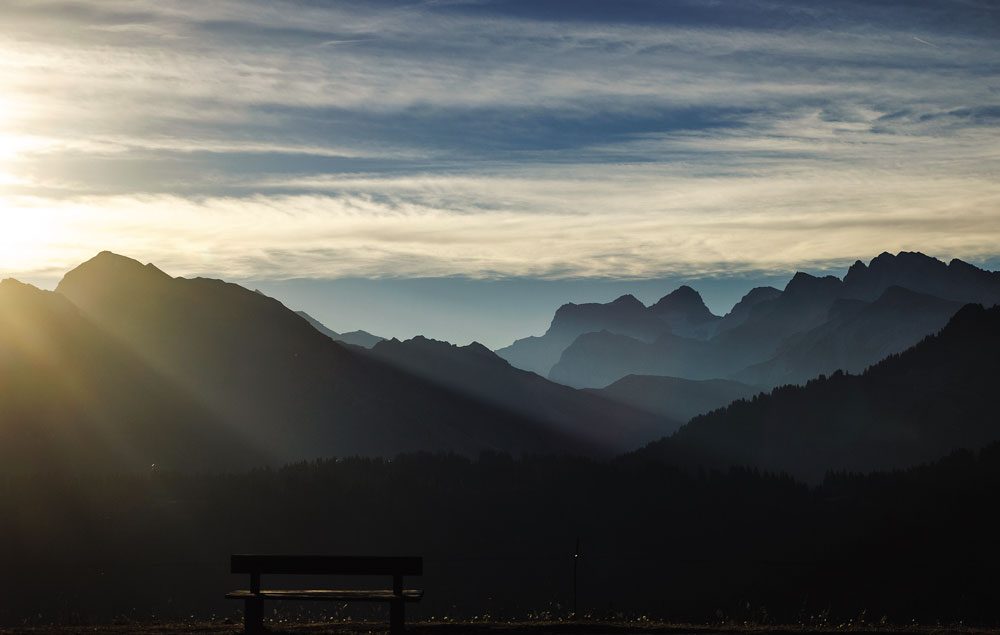
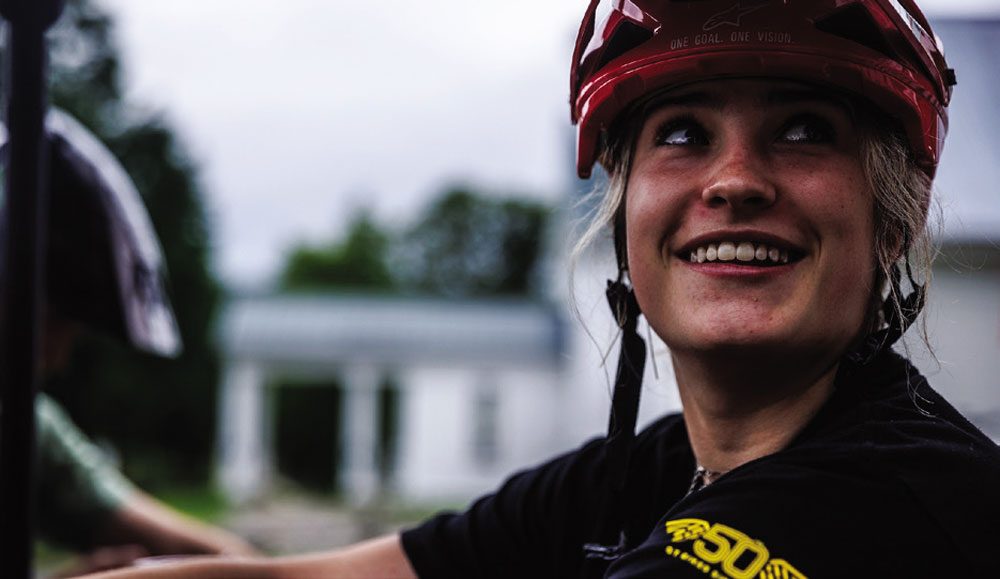
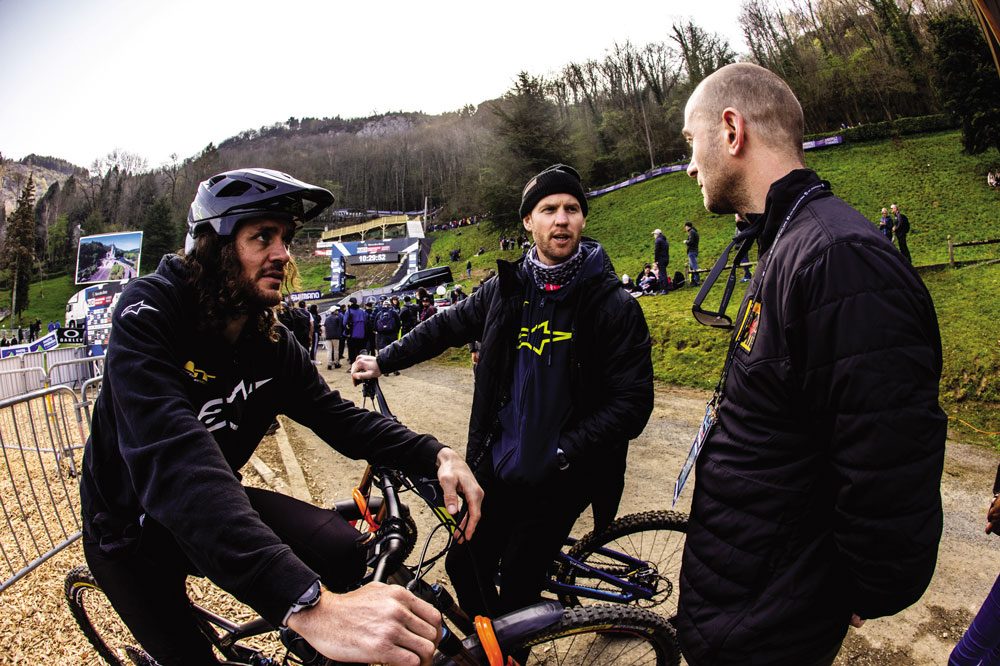
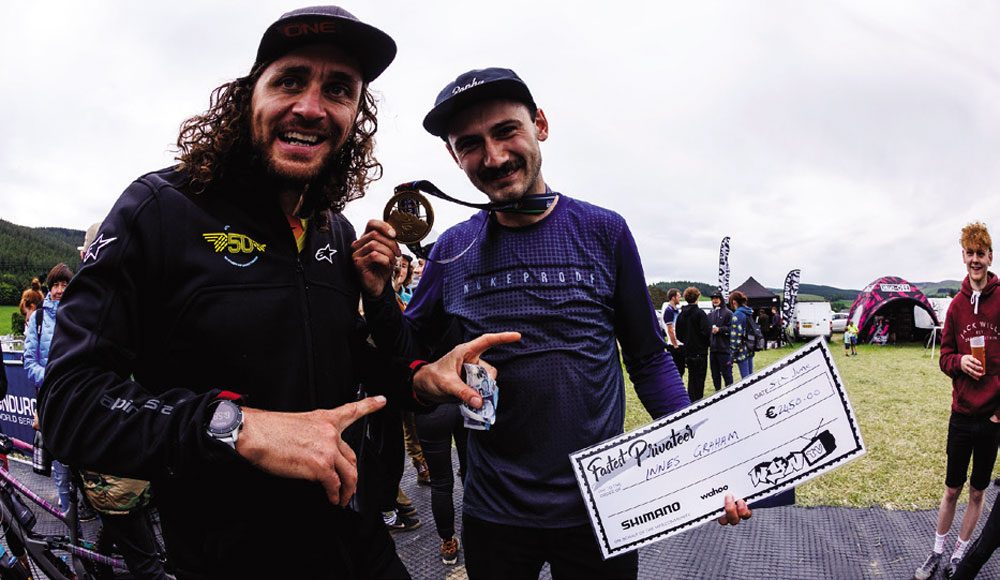
I PERSONALLY FIND IT BETTER TO AT LEAST KNOW WHERE YOU STAND AND FROM THAT POINT FEEL EQUIPPED WITH THE FACTS SO YOU CAN ADDRESS THE SITUATION AS IT PRESENTS.
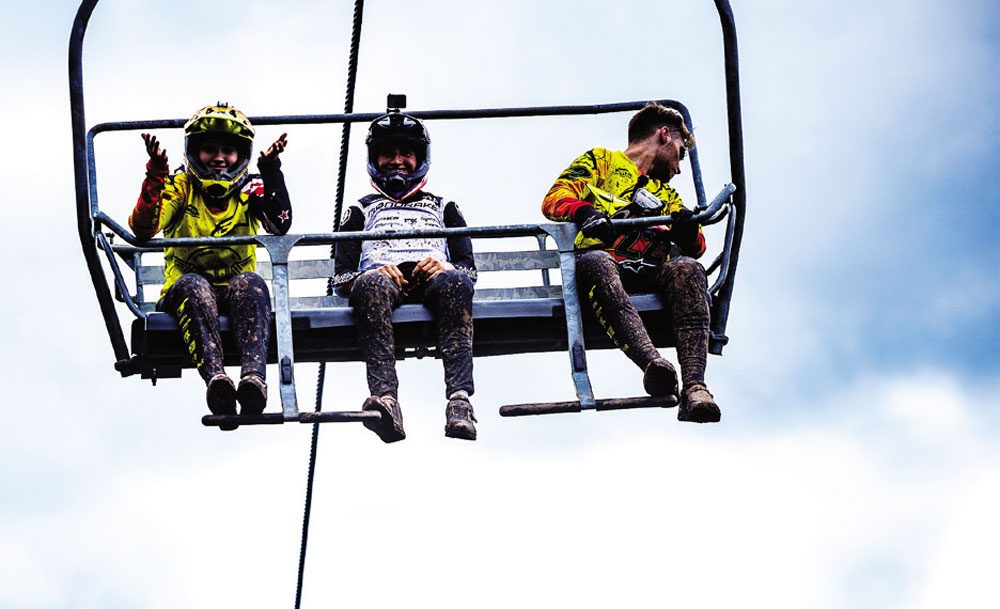
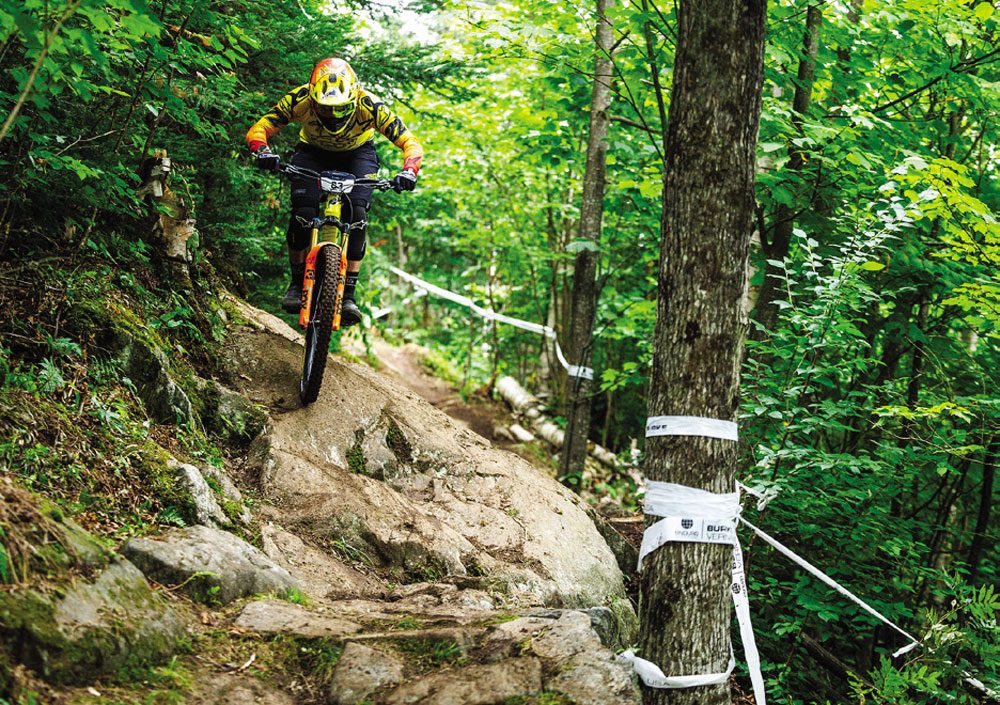
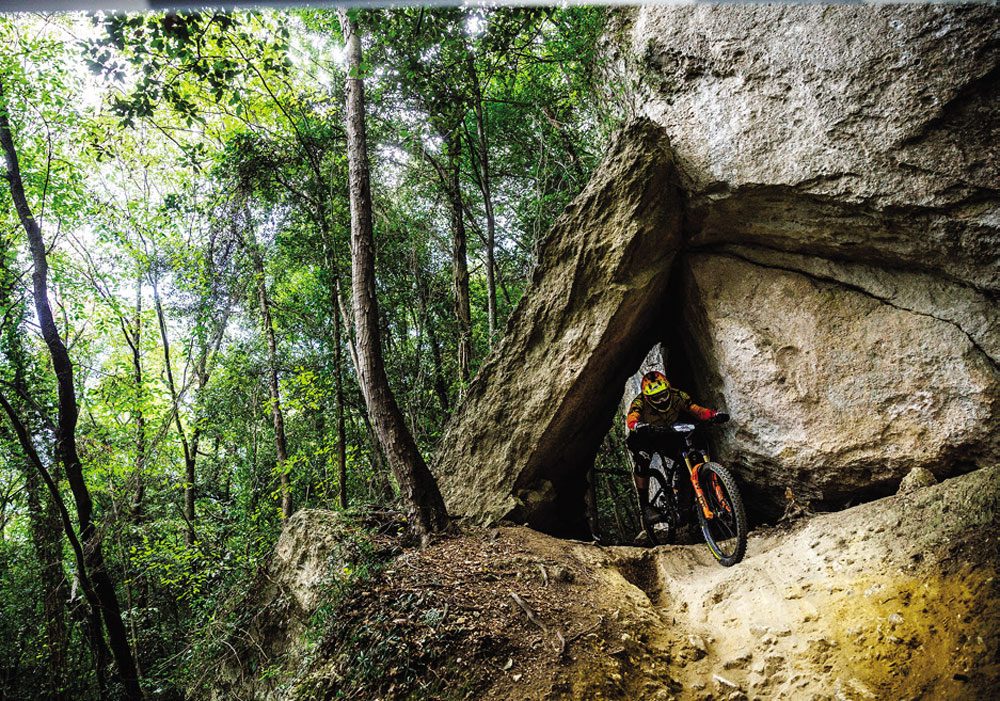
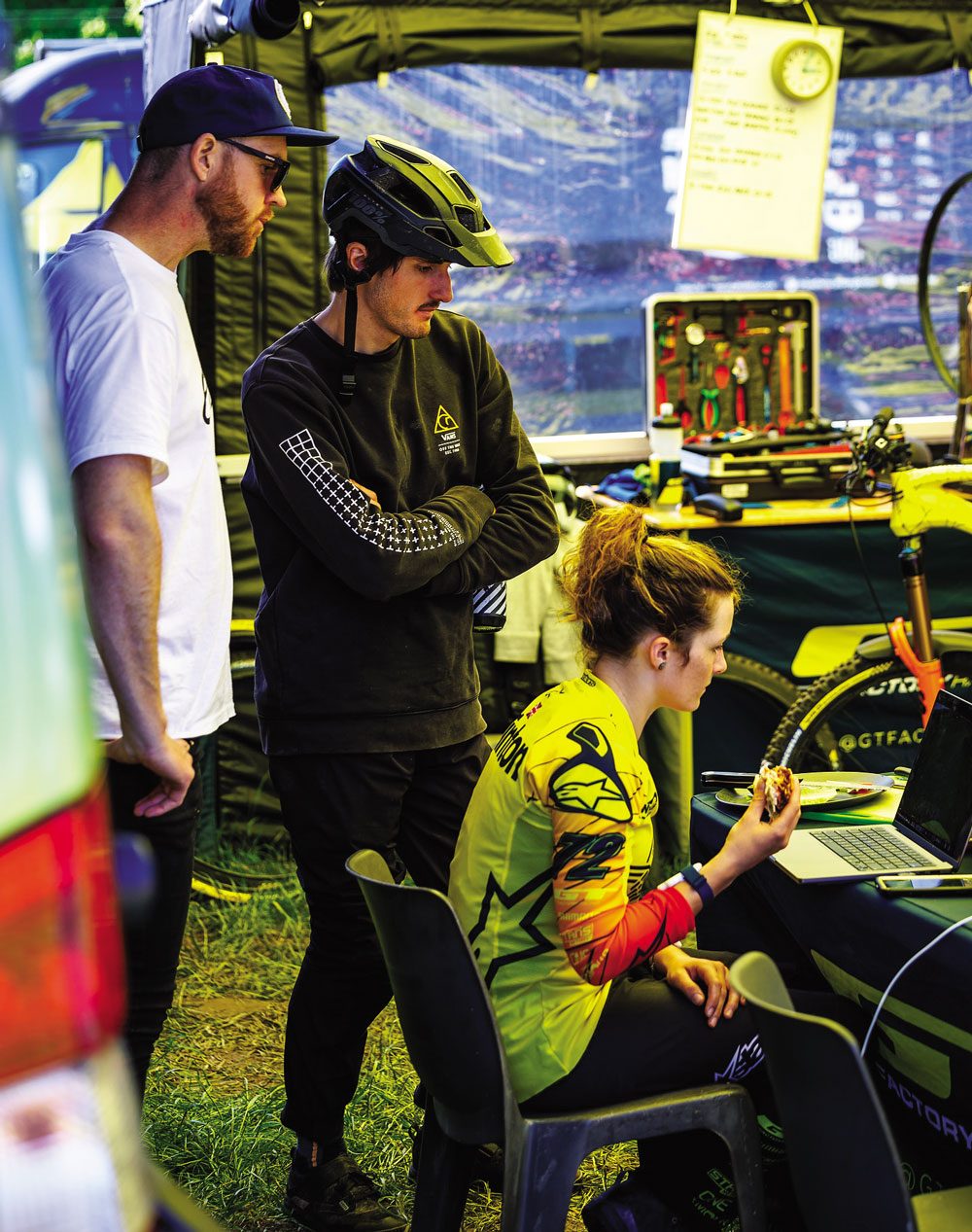
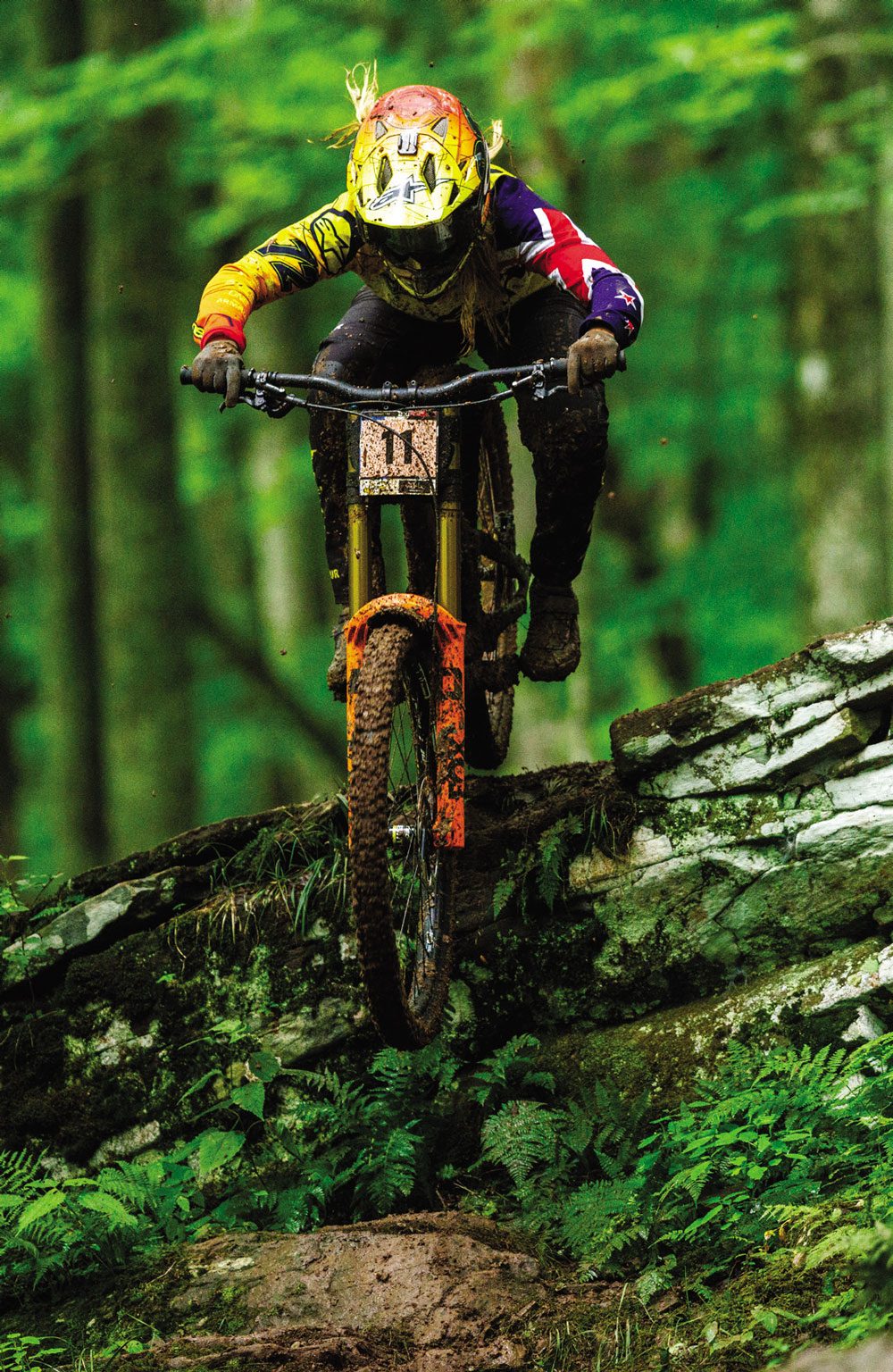
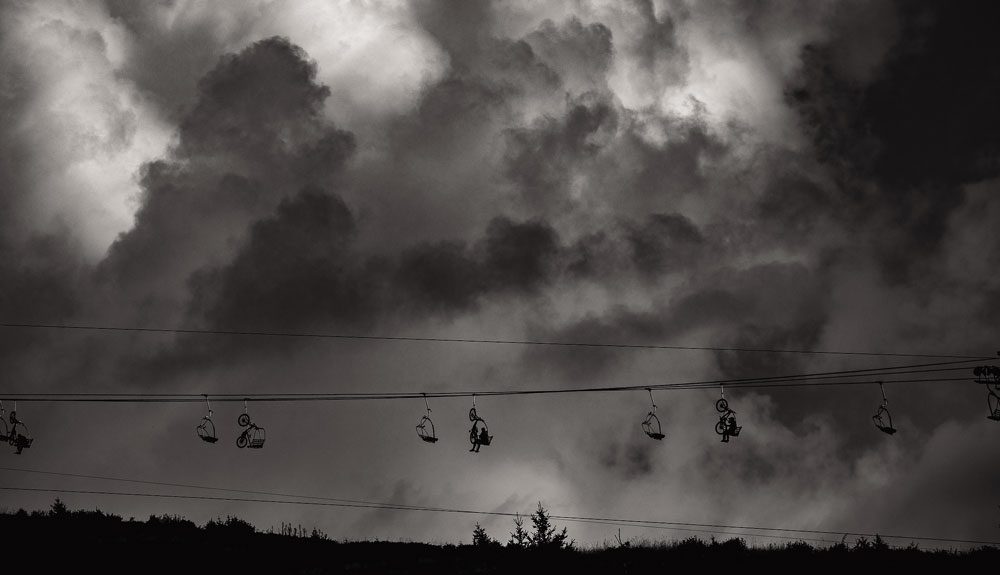
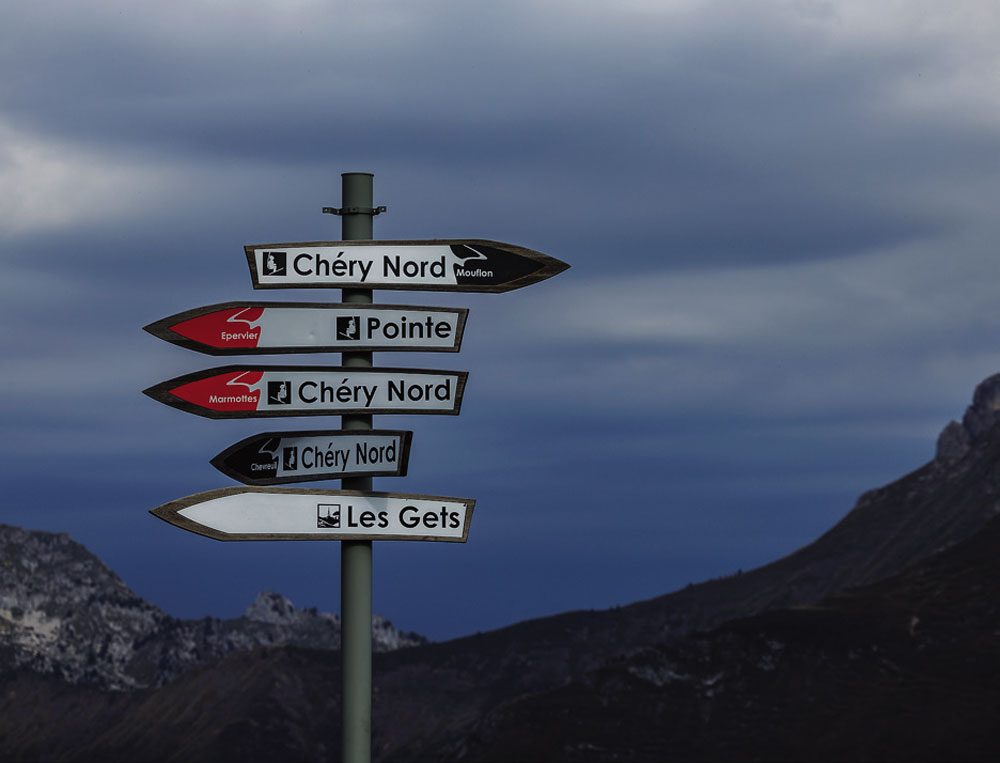
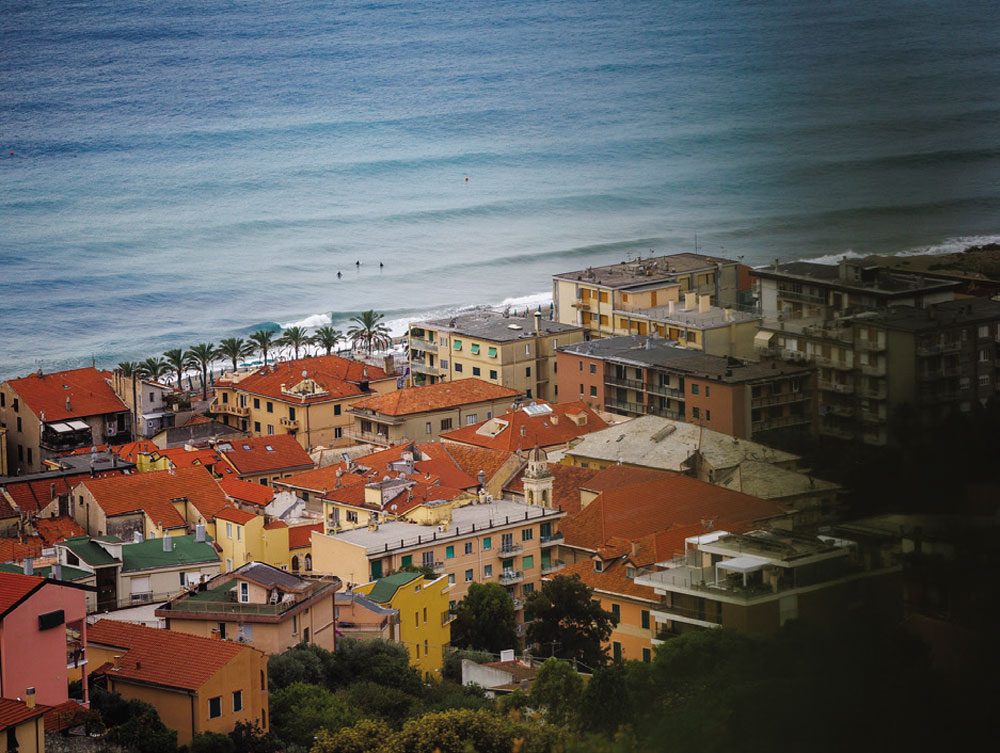
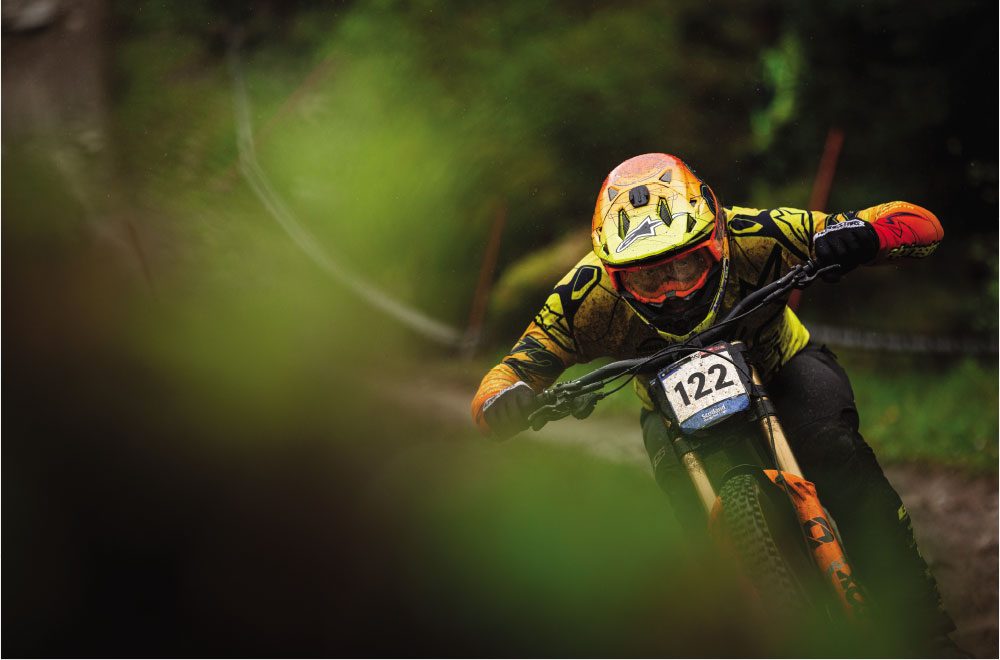

Review: Continental Kryptotal & Xynotal Tyres
Reviewed by Lance Pilbrow
Distributed by Worralls
RRP: $148
Continental have recently done a major overhaul of their gravity tyre offering. The range they offer now is almost overwhelming. Four new names, five new tread patterns, three casings, and three rubber compounds. It’s a lot to get your head around. To try and simplify things, let’s run through the tread patterns, which will help you narrow your choice down to match how dry or wet your riding conditions are. For hardpack conditions you start with the Xynotal tread pattern; mixed terrain is the Kryptotal (front and rear specific tread pattern); the Argotal is for loose terrain; and the Hydrotal is for mud. Got it? We’re just getting started. The Xynotal, Kryptotal and Argotal are all offered in Trail, Enduro, Downhill, or Downhill Supersoft casings (the Hydrotal is only offered in DH super soft). Oh, and then you choose how hard or soft you like your rubber: Endurance (harder); Soft (softer than Endurance); or Supersoft (pretty self-explanatory). Still with me? If you like Subway and getting your Sub just the way you like it, then you’ll be in tyre heaven. For all that choice, width wise, the Kryptotal Re is 2.4” or 2.6”, everything else is 2.4”, and that’s it. Everything is available in 29” or 27.5”.
Ok, so you have lots of variants to choose from. No, I did not test every variant. As much as I love new tyres, I have other things to do with my summer. I’ve been riding the Kryptotal Fr (Front) and Kryptotal Re (Rear) in the Enduro Casing, with the Soft compound, in a 2.4” width, this summer. This probably represents a fairly middle of the road option across the board. The tread pattern on the Kryptotal Fr has a 2-3-2 pattern down the centre, whereas the Re has a consistent 2-2-2 pattern. The Enduro casing has three layers of 110 tpi thread count and weighed in at 1125 gm
Out of the box, the tyres actually just look great. I didn’t know I was so attuned to what a quality tyre felt like, but these are that. The finish on the tyres is top notch. The graphics are perfect and there is a unique kind of embossed pattern in the side walls and in between the lugs. It screams German precision and quality. Getting them mounted up on my WheelWorks wheels was pretty tough, I’m going to be honest. Were these the hardest tyres I’ve ever had to mount? No, but it would be getting close. The casing is incredibly stiff. Just getting them on the rim felt like I was going to break tyre levers or damage my rims. Thankfully, that was all in my head, but it took a LOT longer to get them on than any other tyre I’ve used in the past. Once they were on, they sealed up nicely.
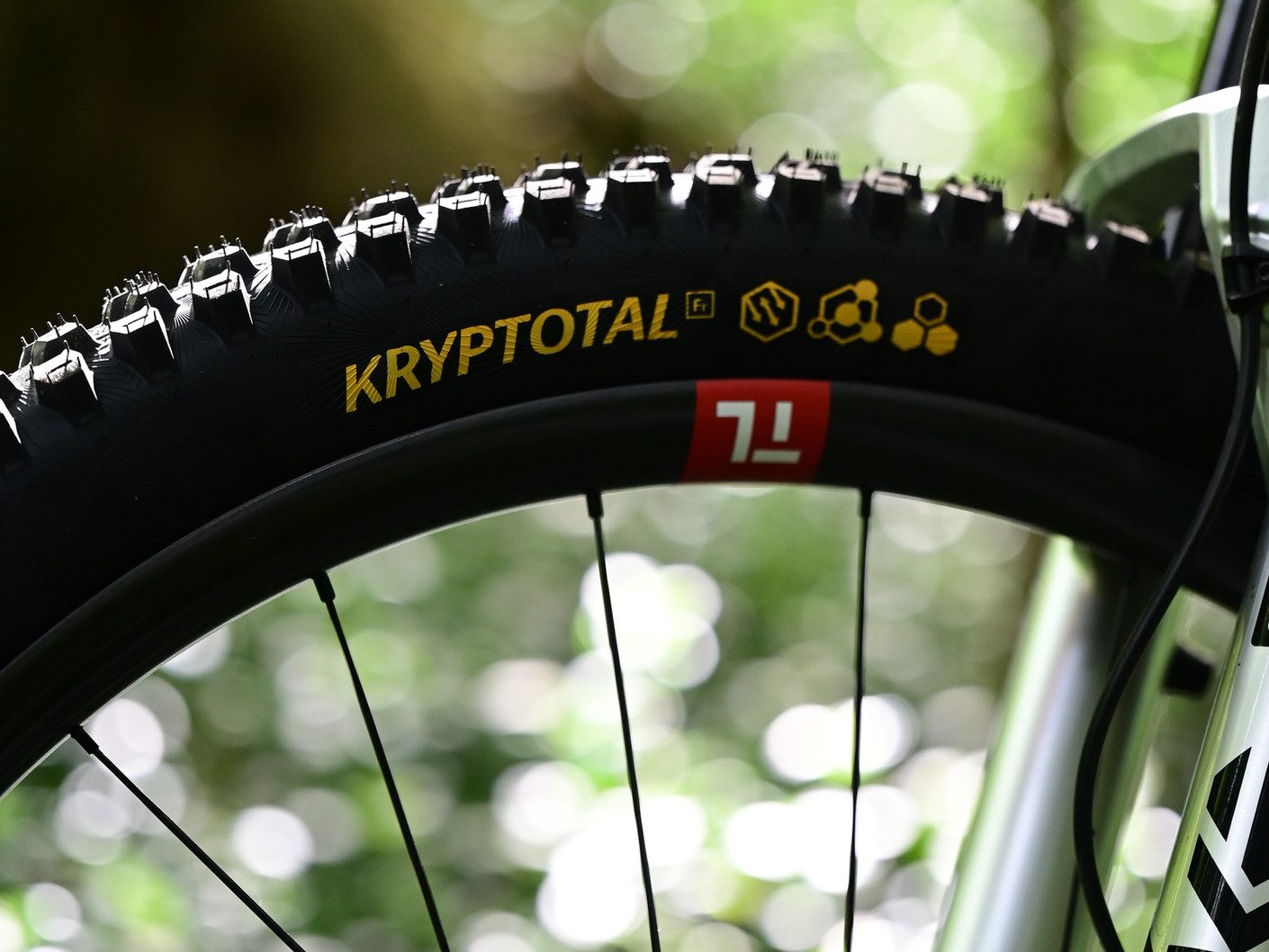
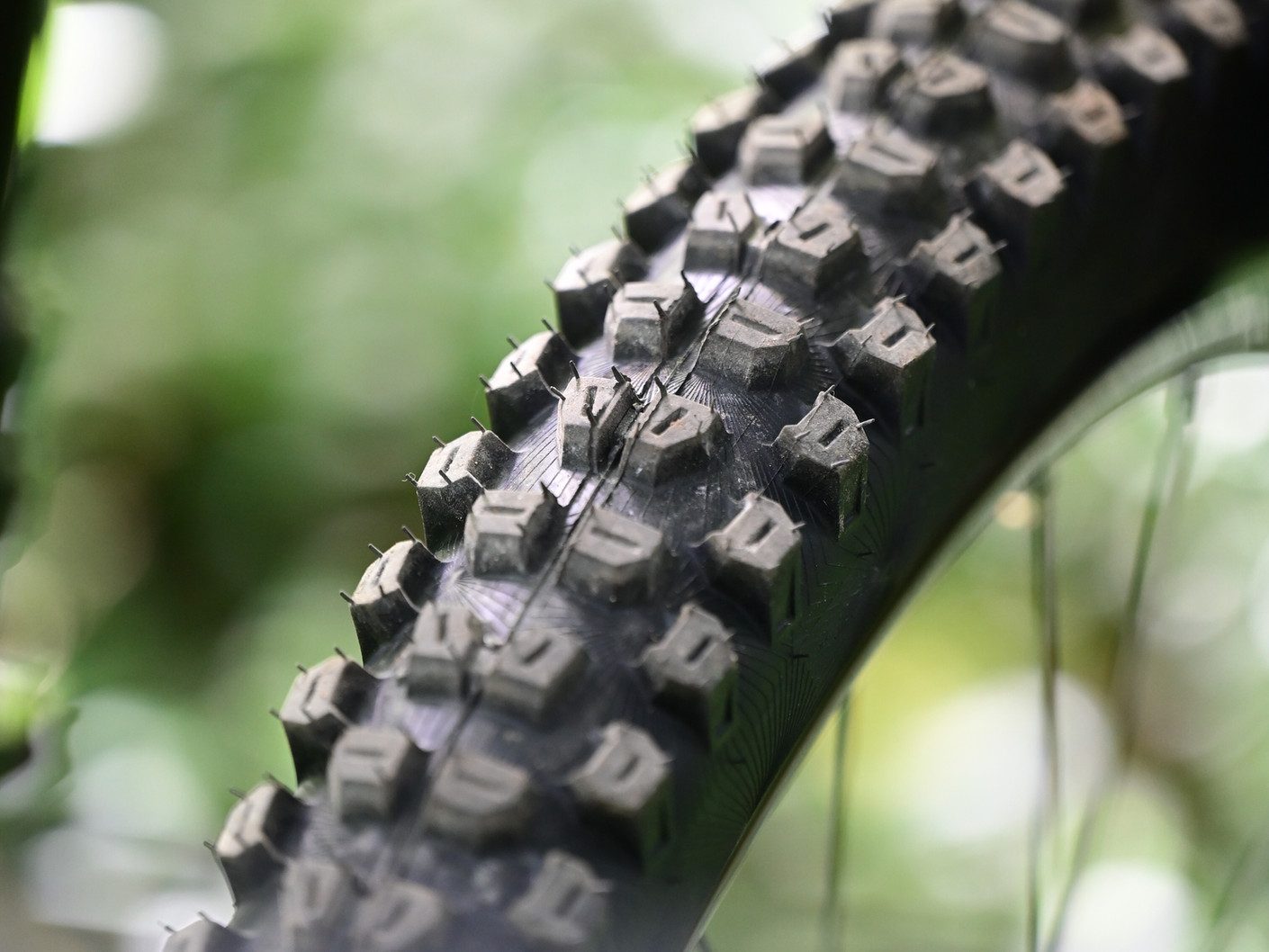
Visually, you can see that these tyres mean business – the lugs are tall and on the front there are generous gaps to help with mud clearance, enabling the tyre to really dig in. Out on the trail I have been really happy with the Kryptotals. The 2.4” width is spot on for trail riding and gives you plenty of rubber for when things get just a bit squirrelly. Having spent a fair bit of time recently on lighter, faster rolling tyres, coming on to the Kryptotals felt like I had traction in spades, and I always felt in control. I could push and push and it would always seem to hold. When heavy braking occurred, it would always hook up strong and this really made me feel confident riding them. I really noticed how, on a few favourite turns, I would try to push through and stay off the brakes, and the Kryptotal held the line incredibly well. Occasionally, I was actually surprised that I didn’t lose the front end, and was left thinking, ‘huh, I rode out of that?!’ with a great big smile across my face. This really helps with confidence and keeping your fingers off the brakes; holding your speed through the corners.
After a summer of riding, I’m happy to say the tyres still look great. The side walls are in great condition, and I haven’t had a single puncture, tear, or burps. If you’ve been a fan of Maxxis Assegai’s or DHR’s then I think you’ll find the Kryptotal to be right up your alley. I’ve been really impressed with these and will be leaving them on my bike for as long as I can. They gave me great confidence to push hard into corners and control when navigating heavy braking down steep descents.

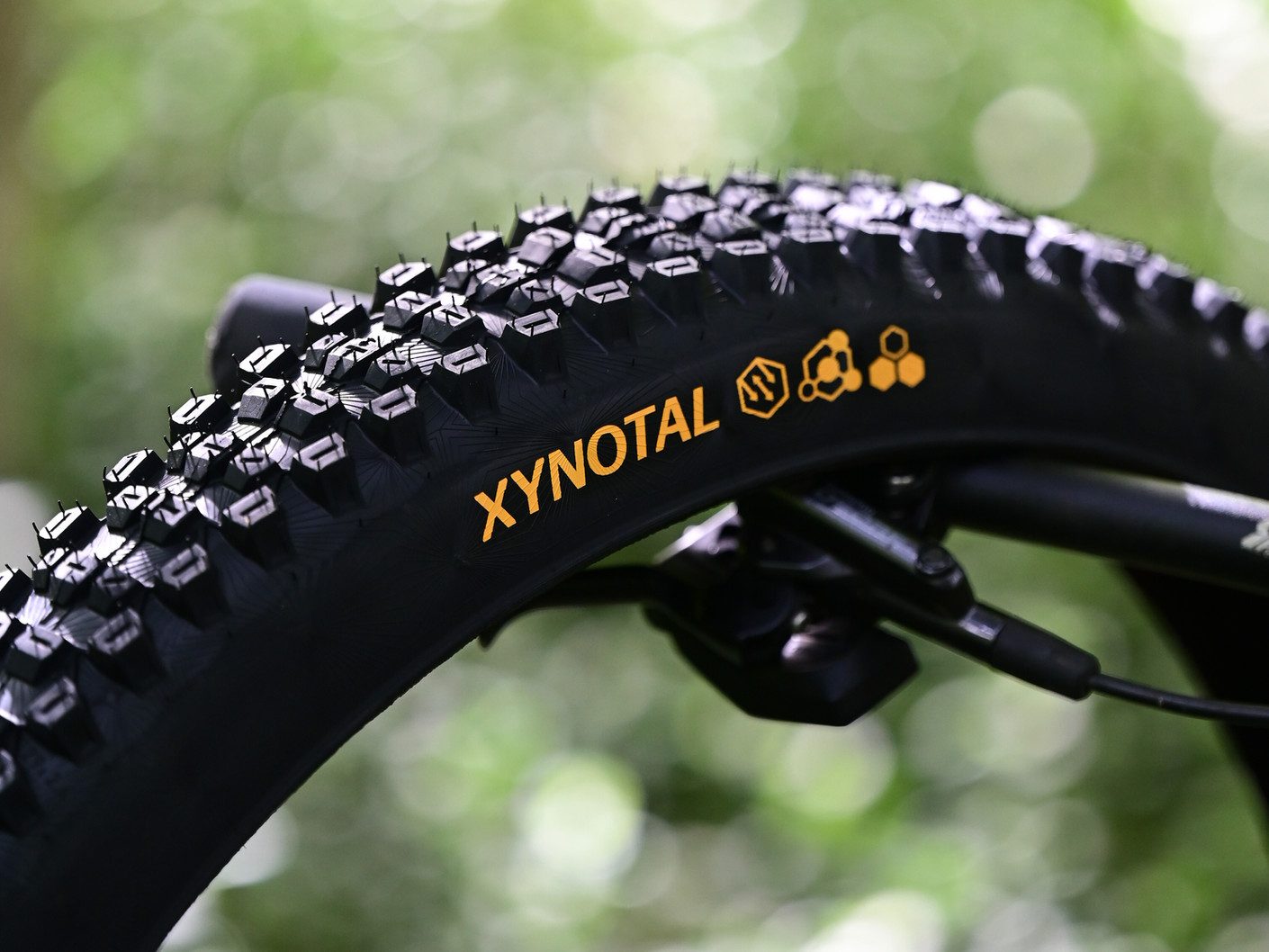
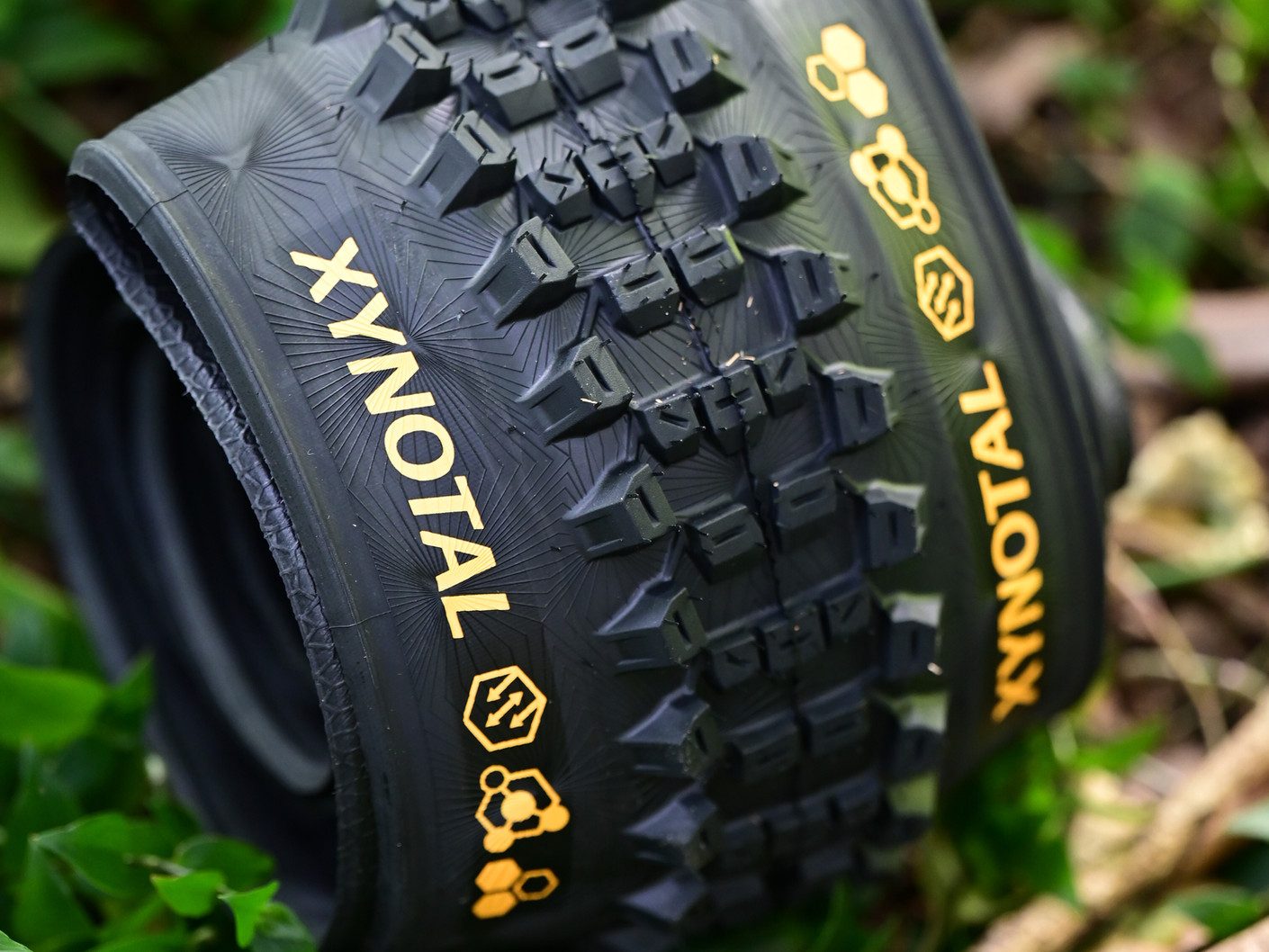
I also was able to spend a small amount of time on the Xynotal tyre too. This one is not offered as front or rear specific and, at a distance, it looks incredibly similar to the Kryptotal Fr. So similar it was a little like one of those ‘spot the difference’ cartoons but, after a bit more of a careful inspection, the Xynotal’s tread pattern is slightly closer together. On the part of the pattern where there are ‘2’ centre lugs, the Xynotal groups these closer together, whereas the Kryptotal keeps these further apart – presumably this helps the Kryptotal with mud clearance and hooking up in looser conditions (which is what it is targeted to do.) The Xynotal’s lugs are also considerably more bevelled down at the leading edge which should help reduce rolling resistance. All in all the Xynotal is theoretically designed for more hard pack conditions and may help the rider retain a bit more speed. On the trail, I found it really hard to tell the difference between the two – aside from generally feeling that the Kryptotal just had a bit more ‘bite’ to it. If I noticed it anywhere, it was on steep chutes under heavy braking. The Kryptotal just seemed to be able to hold traction for that fraction longer. This is all pretty arbitrary really, as it’s hardly a controlled test, but if hardpack conditions are where you ride, the Xynotal would do the job perfectly. As an all-rounder, I’d probably err towards the Kryptotal – and I like the front and rear specific options it gives.
The fact that the new Continental range is offered in so many variations of patterns, compounds and sidewalls is slightly overwhelming at first, but it means you can find a tyre that perfectly suits your riding style. Pricing varies across the range, depending on your variant. The Kryptotal’s and the Xynotal come in at $148 each.

Review: Aeroe Spider Rack
Review by Odin Woods
RRP: $199
Find out more here.
“The Spider Rack system is comprised of a rear rack, rear cradles, front cradle, and some nice dry bag options to suit just about every bikepacking pursuit.”
When I think bikepacking, I think of drop bars, janky bags and loose straps hanging off every corner of the bike.
Some of those janky seat bags, front rolls and frame bags have become more refined over the years – to stop stuff bouncing, swaying, and ultimately falling off your bike – but there still isn’t the perfect solution for all occasions by any means. Consumers pushing for cleaner, simpler, less faffy ways of mounting bags on bikes continues to drive innovation. Innovators, like brothers Mike and Paddy Maguire at Aeroe, have certainly played their part in that move. You can thank them for the original freeload rack (now sold by Thule) – which I’m sure many of you have seen over the years – and now for the Aeroe Spider Rack system. The Spider Rack system is comprised of a rear rack, rear cradles, front cradle, and some nice dry bag options to suit just about every bikepacking pursuit. All the parts have a very modular feel about them, and you can tell each component has had a lot of love poured into it, design-wise, allowing for a very simple and easy-to-use product.
I’m kind of a ‘rip the packaging open first, read the instructions later’ person, and if how something is supposed to work isn’t immediately apparent then, in my opinion, it isn’t effortless for the customer. I applied this logic when first fitting the rear rack to my gravel bike and was quickly impressed with how simple and easily adjustable everything was. The mounting brackets can rotate to accommodate different seat stay angles and the rack itself can flex to achieve different widths. The rack height can also be adjusted +/- 30mm by loosening the four bolts and sliding it up and down through the mount to adjust the clearance around the rear tire. Nipping up the 5mm Allen key, the Silicone coated straps effortlessly tension up to keep the rack secure, without risking damage to your frame.
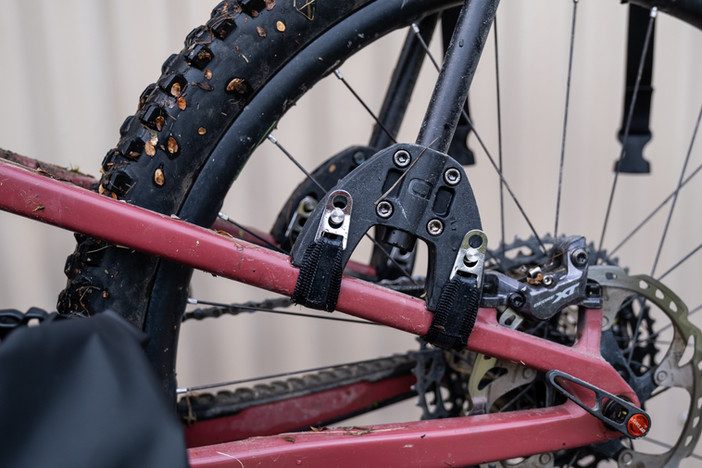
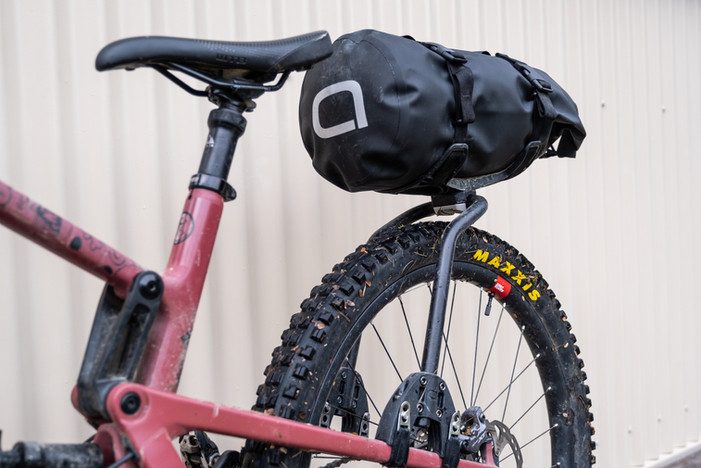
“I more or less forgot that there was a 12L dry bag strapped to the back of my bike. The rack was rock solid and didn’t make a sound.”
I pulled it off and within three minutes had it mounted on my Santa Cruz 5010. I chose to flip the entire rack 180° so the cradle sat back a bit further and lower down to clear my seat on compression. Aeroe note this as a ‘hot tip’ in their install guide.
It was time to put this stuff to use! We gapped it out of town to a quiet wee hut for the night and opted to use the Spider rear rack, with a single cradle, and the 12L dry bag to hump our gear up-river to the night’s accommodation. It was a quick transition in the pouring rain from empty bike to loaded bike. We simply clicked the cradle’s integrated buckles over the dry bag, then we were off. Jordan opted to mount his rack facing back as well, and had plenty of clearance over a 29er rear wheel as we bounced our way across tussock, river lands and the beech forest beyond. Without the usual constant swaying of a loaded seat bag, I more or less forgot that there was a 12L dry bag strapped to the back of my bike. The rack was rock solid and didn’t make a sound. When it came to dismounting and crossing some of the bigger rivers, I could fully drop my seat and climb off easily! Getting to the hut, it was nice to just unclip two buckles and not have to fumble around under the seat trying to pull straps through to remove a bag. My clothes and sleeping bag were nice and dry, courtesy of the super durable dry bags.
Loading up was, again, as easy as stuffing a bag full of gear and strapping it on. I gave my rack the once over just to see if anything had moved, but everything was where it was supposed to be and riding behind Jordan over some of the rougher sections of trail made me realise how little the entire system moved as well.
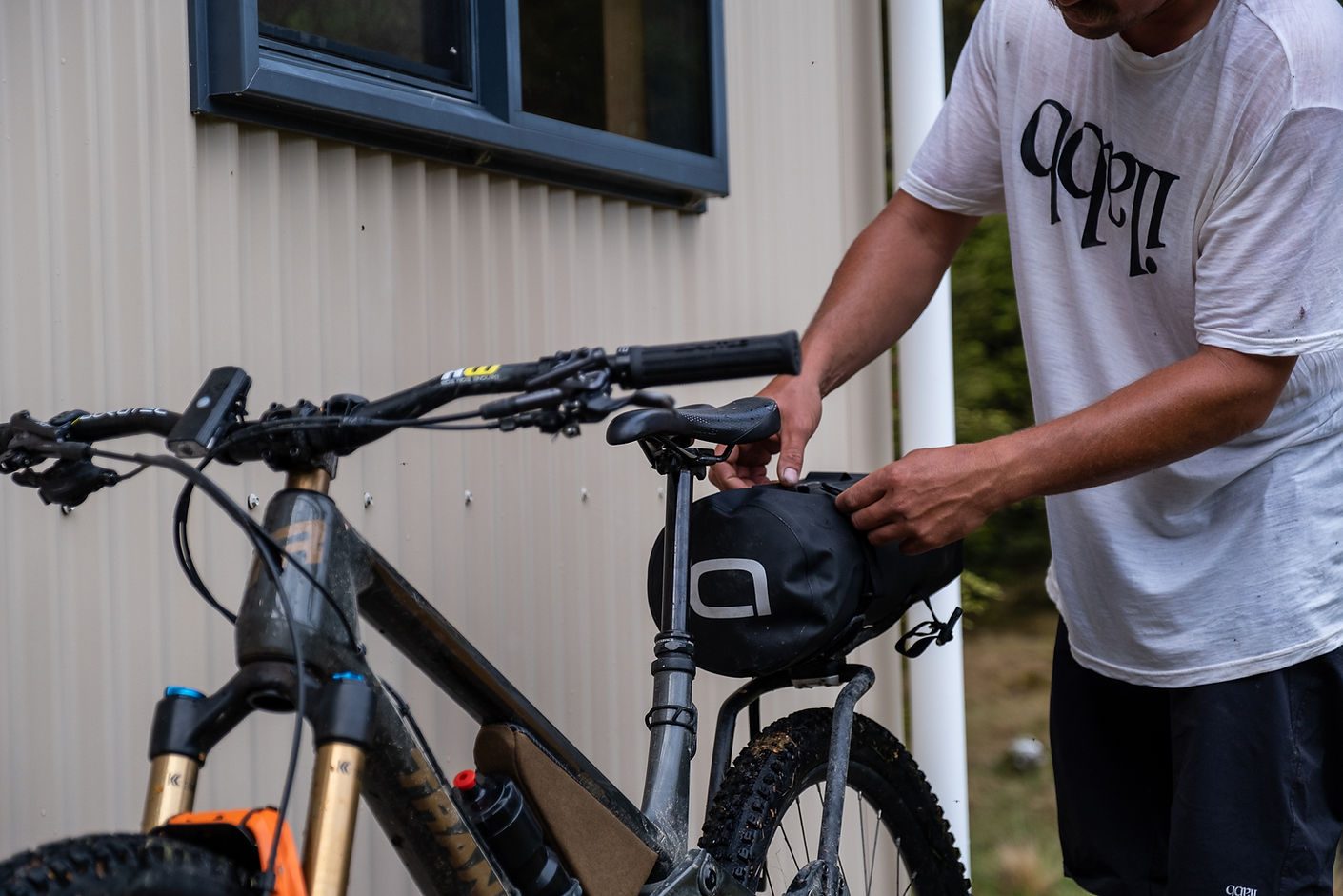
As mentioned, we only used the Spider rear rack with one 12L dry bag, but it’s worth noting that if you wanted to you could add another two cradles to each side and strap on another two dry bags – or a tent, fishing gear, whatever you want. One small thing to mention is that the straps that hold the rack on could be easily lost when the rack is removed, so putting a small rubber band around the end while on the rack would stop them being accidently dropped.
The weight weenies will note that the rack and cradle weigh in at 996 grams, not as light as a seat bag, but there is no questioning the robustness of the rack and cradles solid design. With that in mind, if you are planning to use this system for bikepacking, on rougher trails, it is reasonable to accept the 400-odd additional grams for the sake of longevity.
Rounding out, I found my time using the Spider Rack system sturdy and reliable with no surprises. For the price, I think it’s fairly good buying considering its versatility to move between bikes without too much hassle – plus, you can add to it when you need to.

Feature: Weekend up the Waiau
Words: Jordan Phipps
Images: Odin Woods
The idea of strapping crap to your bike and heading into the wilderness definitely isn’t a new one, but I’ve been feeling the urge to break out. Time to make the effort to get back outside, chuck down the tools and avoid the Christmas rush. Find fun in the misadventure and – for the first time, for me – take the bikepacking offroad.
The perfect opportunity to dip a toe into this niche practically landed in my lap. A long-planned weekend at the Wairoa Gorge was rapidly approaching, which would see me and my buddy, Odin, traversing the South Island. The journey from Christchurch to Nelson dances along the fringes of some unreal backcountry areas, giving us a plethora of rivers and valleys to explore. What better way to start a weekend of gravity-assisted riding than with a bikepacking adventure.
Driving to Nelson isn’t overly long or strenuous, but when schedules are tight and optimising time away from home is key, an after-work departure is best. Some folks may just opt for a hotel or even whack up the rooftop tent to break up the drive when tired, but when activities take priority, a backcountry hut makes perfect sense…
Stuffing a dry bag full of snacks, camping gear and the occasional hazy (of course), you’ve now got the perfect recipe to start any adventure. I’ve learned over the years, there are three things you usually like to line up to help aid a positive experience while out in the backcountry. None of them are exactly critical but a lack of all three definitely makes life slightly harder, colder and, ahh, less positive:
Good weather.
Ample daylight.
Cold beer.
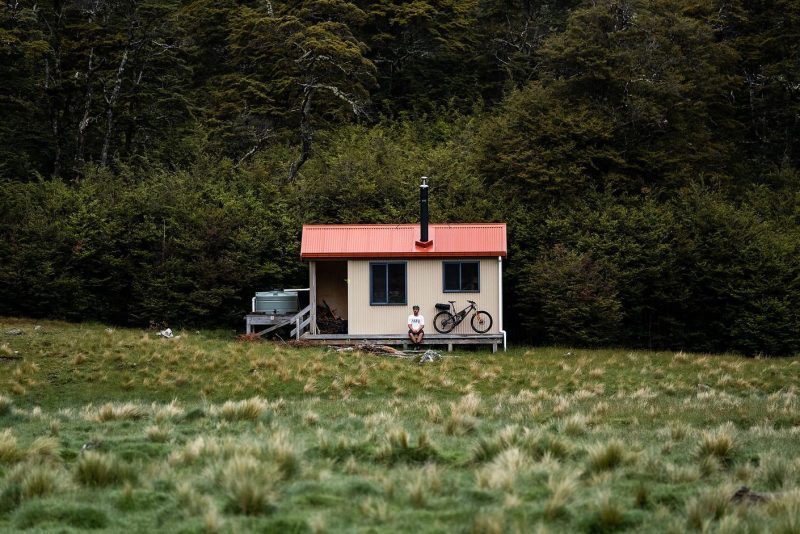
A plan formed and before long we began the battle out of civilisation. Bumper-to-bumper rush hour traffic filled the roads, with the silly season undoubtedly upon us. Shop fronts were adorned with Christmas livery, and footpaths struggled to contain the masses. My mind begins to wander: have I got my partner the right thing for Christmas? Shit, did I remember to book the campsite for New Year’s Eve? Am I going to be able to pull off a flawless pav on Christmas Day? In my present reality, the only pressing questions were when the traffic was finally going to move and which flavour dehydrated meal I should have for dinner that night.
The slow crawl across the city only intensified the urge to get the hell outta there and be completely immersed in the wilderness. Eventually, the houses thinned out and the tar seal quickly turned to gravel. The inconvenience of the city and that pesky traffic became nothing but a smoke-fuelled memory.
The Landcruiser was loaded to the gunnels: two different disciplines and a weekend’s worth of supplies had stretched our Tetris packing skills. This was demonstrated almost as soon as we hit the first 4WD track – everything that could possibly fall off the shelves and create chaos through the interior, did. As bags collected our heads, we were forced to stop and rearrange, taking the time to observe the dank playground that sat in the valley below.
Alas, the peaceful serenity was momentarily broken by the sound of the windscreen wipers reaching Mach 10 on the Landcruiser. Cool, it was raining…
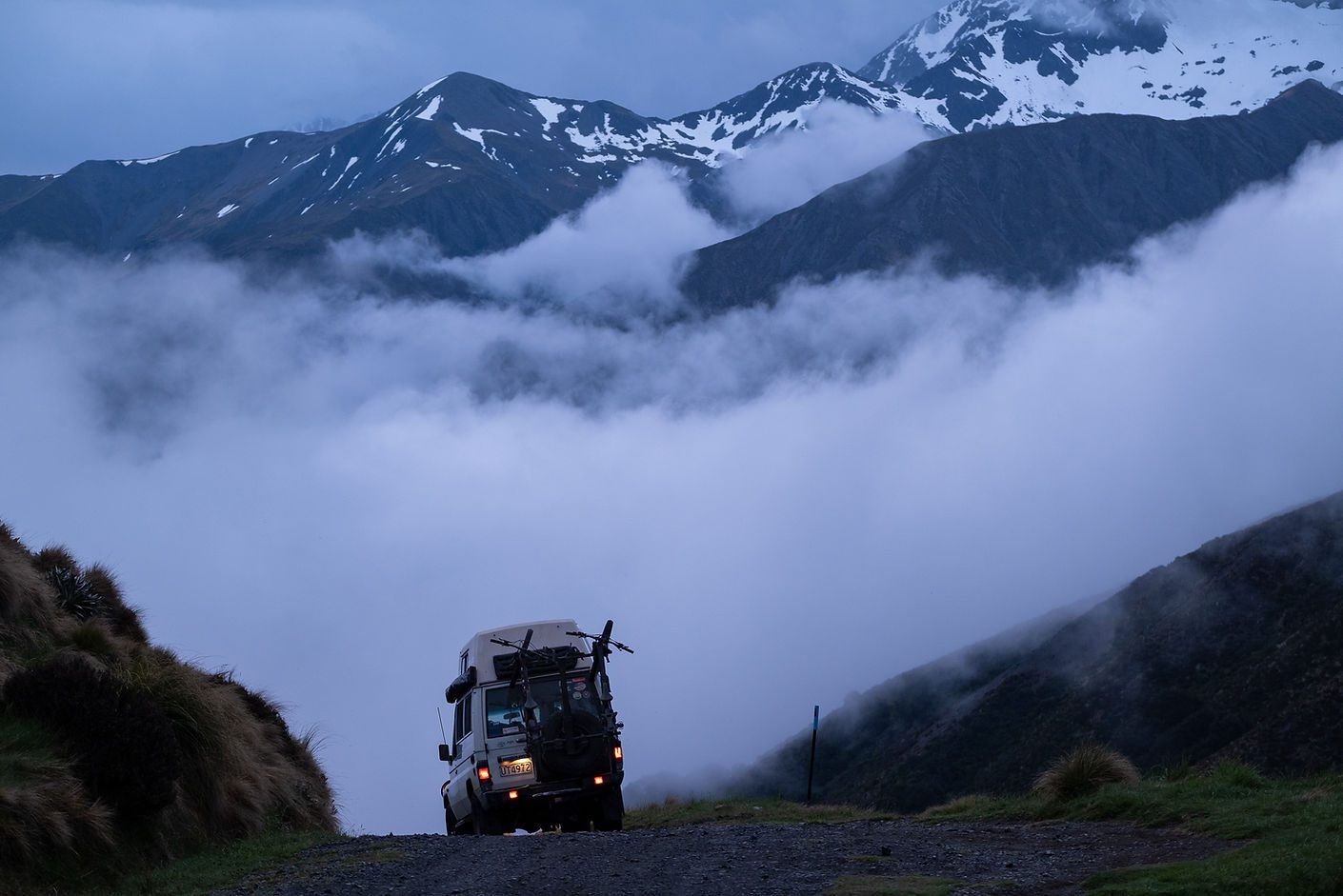
I downshifted the truck and let the old girl roll down the hill, headlights on as we watched the sun dip below the snow-capped peaks. The weather was packing in and the daylight running away, but hey – at least we’d made it outta the city. Plus, we still had beer.
Under the last ounce of light, we parked the old girl up, had a quick shuffle of gear, then strapped our dry bags down to their racks. With our head torches illuminating the way, our road had become a singletrack adventure. New to me for this excursion, was the Aeroe spider rack system. The simplicity of having a drybag strapped to the back of my bike while still maintaining use of a dropper post was a win indeed. With no movement or the admin of having to stop mid-ride and tighten anything up, this product got a thumbs up from me.
I’d never actually ventured into this part of the country before, but Odin assured me I was in for a treat. A narrow goat trail through tussock flat lands carried us away from the carpark and upstream towards the mountains. Navigating seemed a breeze… for the time being.
It’s strange, but for some reason I tend to always be overly confident in my navigational skills. There’s not really any skill set or valid reason to justify why, I’ve just always been the one to charge ahead and find the way. But, as it transpired, navigating from one small orange DOC marker to the next in the dark is a skill I’ve yet to learn. Toppo maps came out and assurances were made that as long as we were heading upstream, eventually we’d reach the hut. Right? Oh yeah, and technically ‘upstream’ also means ‘downstream’, ‘back across stream’ and ‘across that other stream’, too.
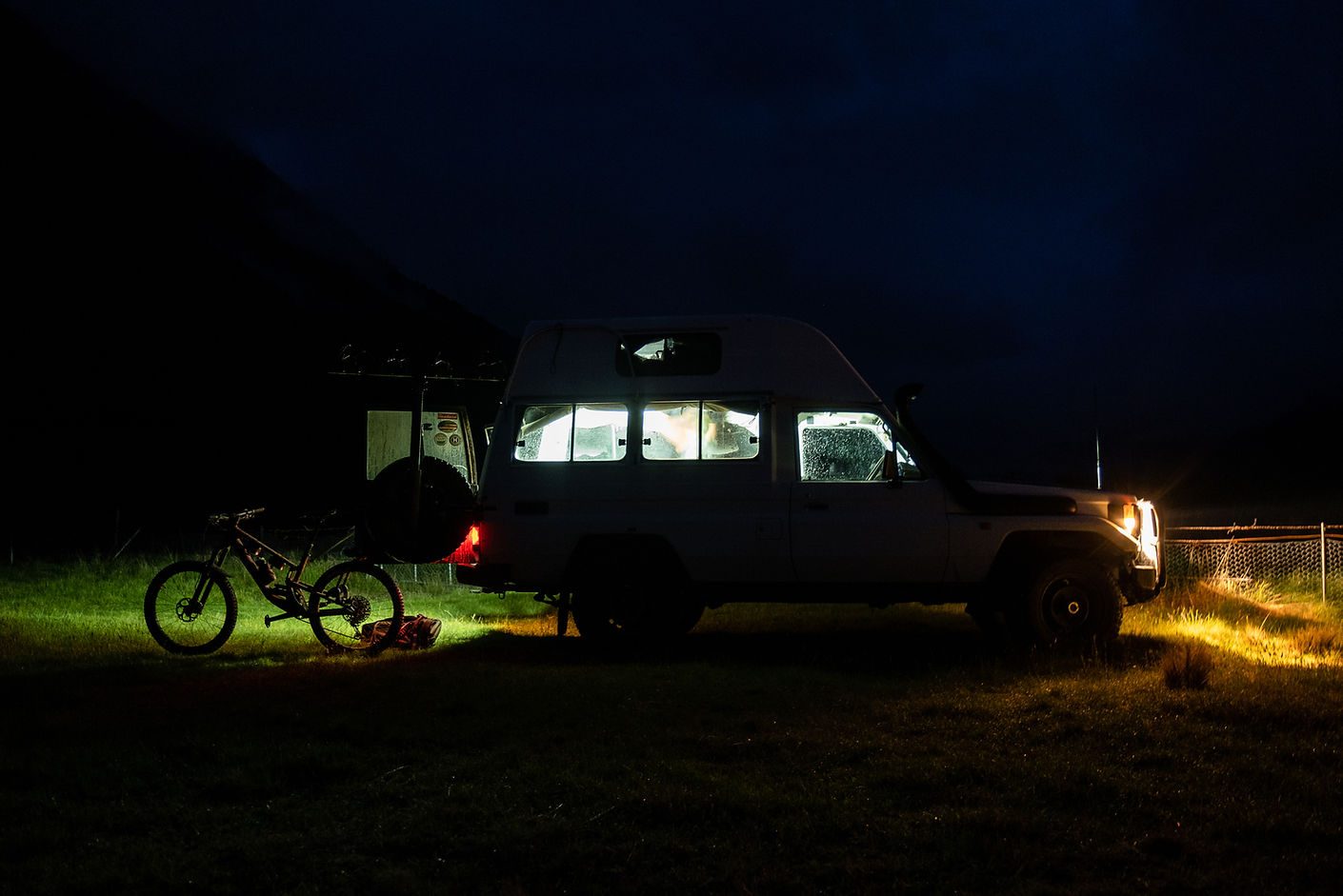
We were, by then, doused in darkness and navigating river crossings, however, the dedication to sustaining dry feet was strong. Our shoes stayed firmly strapped to our handlebars, and socks tucked in our pockets – a decision I questioned as my bare feet felt helplessly for the path ahead, fumbling over rocks and navigating the murky waters one dainty step at a time. It was about then that I reminded myself; ‘it’s not the destination, it’s the journey’. Or was it #notallwhowanderarelost? Either way, the realisation that only a few hours previously I was slinging tools at work and watching the hours slowly tick by, yet now here I was immersed in the wilderness, wading upstream, bike in tow, pushed me further into the unknown.
I don’t know about you, but to me, that’s pure bliss.
Our chosen abode for the night happened to be placed on the Te Araroa trail. We started to broach the subject that there was every chance the hut would be chocka block full of other intrepid travellers, and the question arose of whether we would be pitching our tent in the rain? What was proper hut protocol when arriving late at night? Ah well, I decided that was future Jordan’s problem, and kept the pedals turning.
This was night riding like I’d never experienced it before. To be fair, it was more a combination of multi-sport, orienteering and cycling all thrown into a mixing pot of Type 2 adventure. Mental notes were made on which sections to avoid on our return ride through, and which rock cairns were actually helping us. Somehow, it seemed that each time we’d battle our way through an off-piste excursion, we were only ever metres away from the trail.
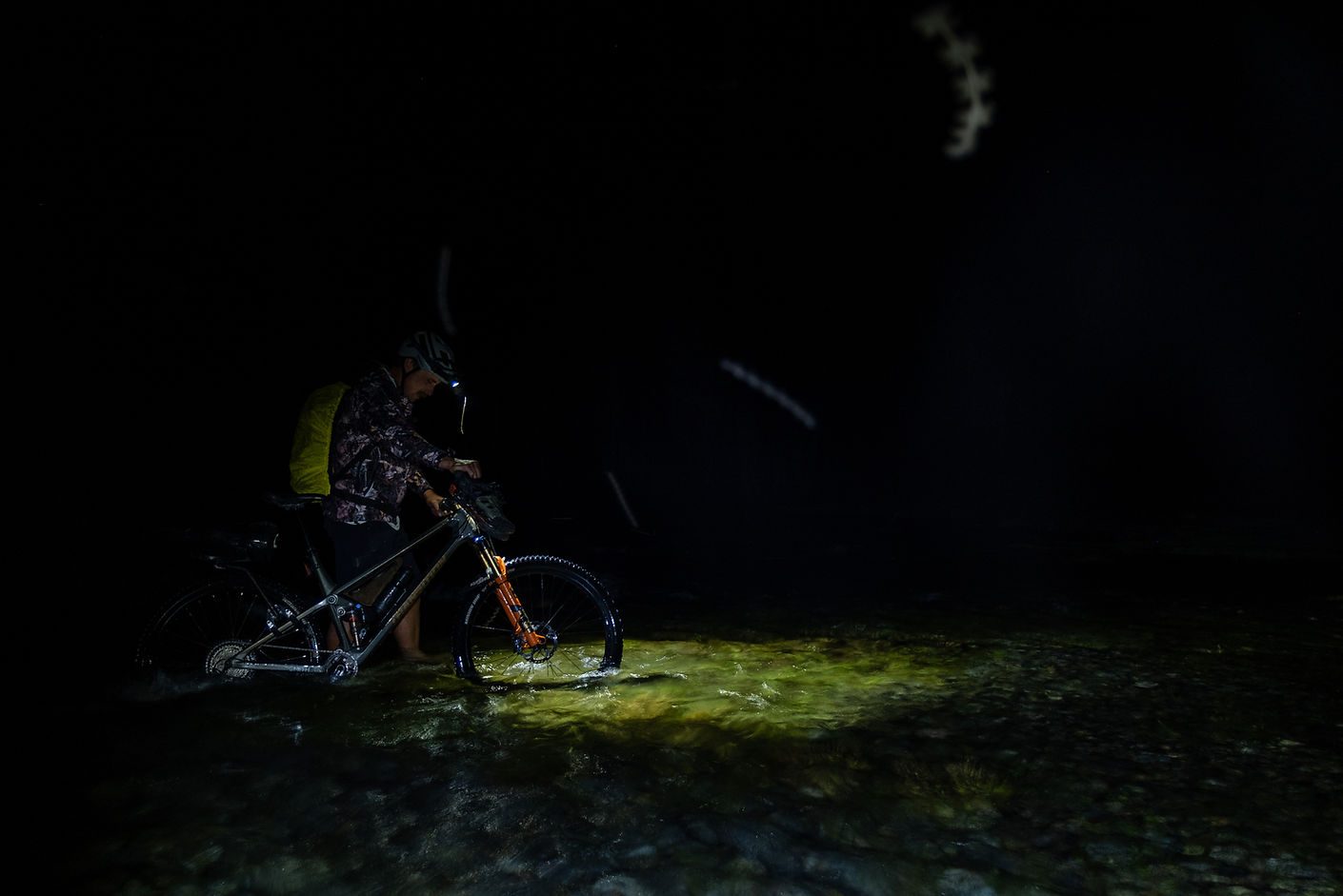
Finding ourselves on opposite sides of the river, we reconvened to once again check our course. After a couple of hours of fumbling athletically through the dark, we had success – the hut was in reach and the legs could sense it, so we cranked up through the dank beach forest and summited the last climb. I soon found myself yahooing, taking in the cornflake descent, corners getting slapped, and any feeling of tiredness seemingly having left my brain.
Sliding to a stop, we couldn’t believe our luck – checking, then double checking, then triple checking that we did indeed have an empty hut at our disposal. Yes, an empty hut! We couldn’t believe it; our intrepid trail of cornflakes had led us right to the front door and not a soul was in sight. Our bikes were safely tucked away and, with two simple clicks, my dry bag was released from its cradle. Ahh, that first crispy beer was cracked.
Hut life is an easy life – not to mention, a much-needed change of pace from the standard 9 – 5 back home. It’s the simple things for me: the rhythmic crackle of a fire and the anticipation of a dehydrated meal. We were more than content. This was a heck of a way to spend a Thursday night. With the fire cranking and beverages poured, the quality of our chat started to fade and it wasn’t long before the night slipped away.
The beauty of arriving at 11:30pm the previous night was that neither of us actually knew what to expect of our surroundings when we woke the following morning. Our subpar porridge was inhaled while glassing the numerous slips and clearings, adamant to scan some creatures. This trip, as all of them seem to be these days, was a squeeze in our schedule. It was the sort of trip that, at the time, could have felt rushed and a tad flustered, but that’s when it’s key to remember something like this is always worth doing.
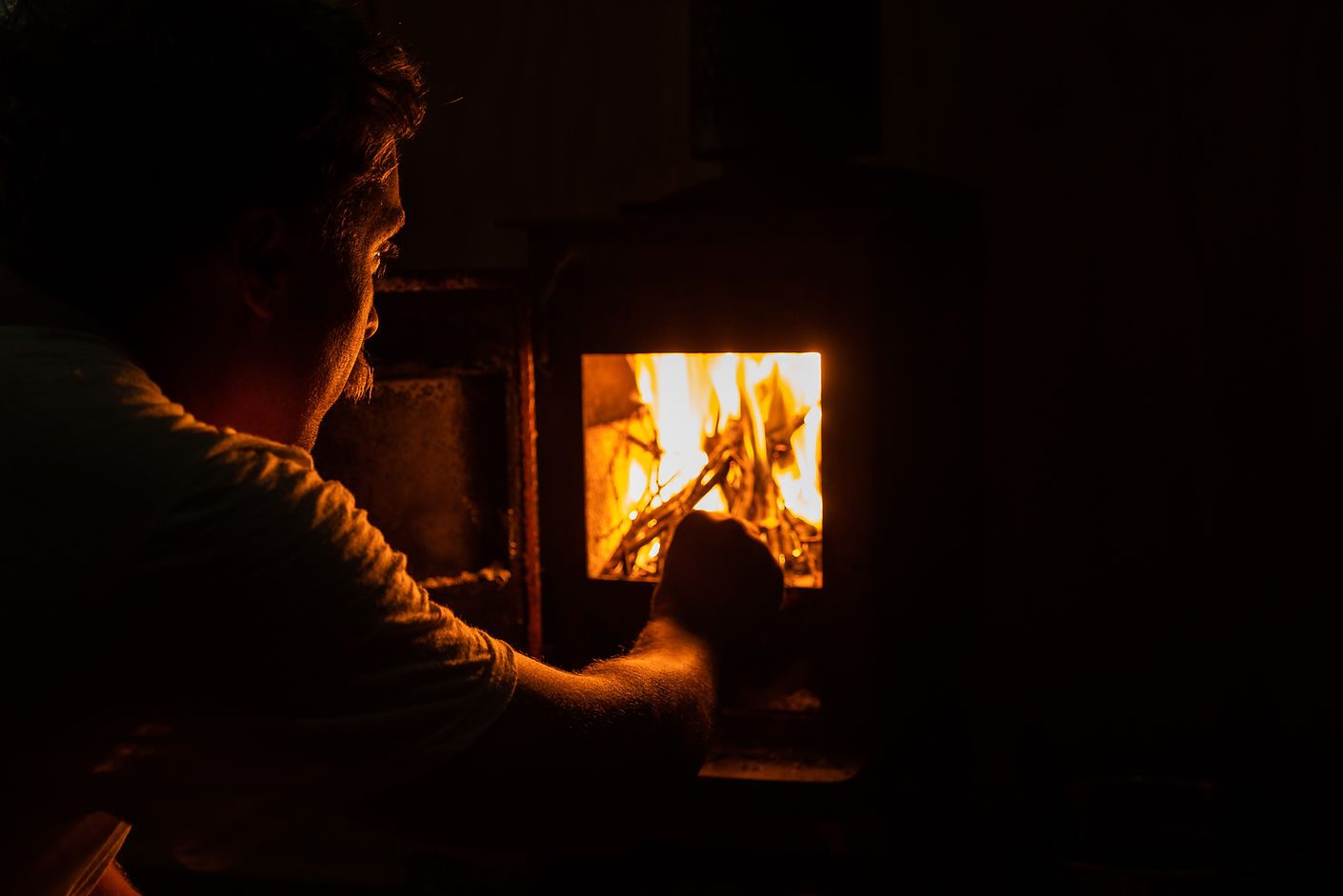
After a morning scanning and exploring the terrain, our bags were back on as quickly as they were unpacked, ready for the downstream trip – which we expected to be an absolute treat. I was quickly humbled by how off track my self-proclaimed mastery navigation skills were the previous night, as the amount of river crossings were halved. The sheer vastness of the valley was hard to absorb.
On any adventure, every positive is balanced with a – sometimes – a small negative. The small negative on this trip was the kind that liked to fly around our faces and bite any exposed skin. Sandflies weren’t going to put a damper on this trip, but boy did they give it a nudge. Luckily for the sandfly population, the majestic sight of the Landcruiser was on the horizon. We’d managed to make it back to the truck in half the time and almost half the distance we’d covered the previous night, but both exploits were just as fun.
Sometimes life needs a bit of spice. Not necessarily the whole Cajun vibe, but maybe more of a paprika hit. It doesn’t take much to mix it up and get out of your environment and into another. Squeeze it in the schedule and get it done. You might be surprised how enjoyable a moonlight ride upstream in the rain actually is.
